–
太極拳圖
TAIJI BOXING PHOTOGRAPHED
褚民誼
by Chu Minyi
[published by 上海九福有限公司發行 The Many Blessings Company of Shanghai, 1929]
[translation by Paul Brennan, Feb, 2016]
–
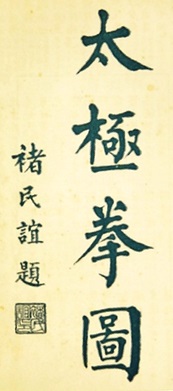
太極拳圖
Taiji Boxing Photographed
褚民誼題
– calligraphy by Chu Minyi
–

褚民誼先生之玉照
Portrait of Chu Minyi
–

褚民誼先生之體魄
Chu Minyi’s physique
–

吳鑑泉先生之玉照
Portrait of Wu Jianquan
太極拳專家吳鑑泉先生
Taiji Boxing expert Wu Jianquan
–
太極拳圖目次
CONTENTS
黃序
Preface by Huang Chujiu
褚序
Preface by Chu Minyi
(一)太極拳論
One – The Taiji Boxing Treatise
(二)太極拳經
Two – The Taiji Boxing Classic
(三)十三勢歌
Three – Thirteen Dynamics Song
(四)十三勢行功心解
Four – Understanding How to Practice the Thirteen Dynamics
(五)打手歌
Five – Playing Hands Song
(六)太極拳姿勢之名稱及其次序
Six – The Taiji Boxing Postures Names in Sequence
(七)太極拳圖次序
with the Taiji Boxing photos in sequence
第一圖 太極
1. TAIJI POSTURE
第二圖 太極起式
2. BEGINNING POSTURE
第三圖 攬雀尾(一)
3. CATCH THE SPARROW BY THE TAIL – Part 1
第四圖 攬雀尾(二)
4. CATCH THE SPARROW BY THE TAIL – Part 2
第五圖 攬雀尾(三)
5. CATCH THE SPARROW BY THE TAIL – Part 3
第六圖 單鞭
6. SINGLE WHIP
第七圖 提手上勢(一)
7. RAISE THE HAND – Part 1
第八圖 提手上勢(二)
8. RAISE THE HAND – Part 2
第九圖 白鶴亮翅(一)
9. WHITE CRANE SHOWS ITS WINGS – Part 1
第十圖 白鶴亮翅(二)
10. WHITE CRANE SHOWS ITS WINGS – Part 2
第十一圖 摟膝拗步(左)
11. BRUSH KNEE IN A CROSSED STANCE – Left
第十二圖 摟膝拗步(右)
12. BRUSH KNEE IN A CROSSED STANCE – Right
第十三圖 手揮琵琶
13. PLAY THE LUTE
第十四圖 進步或卸步搬攔捶(一)
14. ADVANCE (OR WITHDRAW), PARRY, BLOCK, PUNCH – Part 1
第十五圖 仝上(二)
15. ADVANCE (OR WITHDRAW), PARRY, BLOCK, PUNCH – Part 2
第十六圖 如封似閉
16. SEALING SHUT
第十七圖 抱虎歸山
17. CAPTURE THE TIGER AND SEND IT BACK TO ITS MOUNTAIN
第十八圖 斜單鞭
18. DIAGONAL SINGLE WHIP
第十九圖 肘底看捶
19. GUARDING PUNCH UNDER THE ELBOW
第二十圖 倒輦猴(一)
20. RETREAT, DRIVING AWAY THE MONKEY – Part 1
第廿一圖 倒輦猴(二)
21. RETREAT, DRIVING AWAY THE MONKEY – Part 2
第廿二圖 斜飛勢
22. DIAGONAL FLYING POSTURE
第廿三圖 海底針
23. NEEDLE UNDER THE SEA
第廿四圖 扇通背
24. FAN THROUGH THE BACK
第廿五圖 撇身捶
25. TORSO-FLUNG PUNCH
第廿六圖 雲手(一)
26. CLOUDING HANDS – Part 1
第廿七圖 雲手(二)
27. CLOUDING HANDS – Part 2
第廿八圖 高探馬(左)
28. RISING UP AND REACHING OUT TO THE HORSE – Left
第廿九圖 分脚(右)
29. KICK TO THE SIDE – Right
第三十圖 高探馬(右)
30. RISING UP AND REACHING OUT TO THE HORSE – Right
第卅一圖 分脚(左)
31. KICK TO THE SIDE – Left
第卅二圖 轉身蹬脚(一)
32. TURN AROUND, PRESSING KICK – Part 1
第卅三圖 轉身蹬脚(二)
33. TURN AROUND, PRESSING KICK – Part 2
第卅四圖 進步栽捶
34. ADVANCE, PLANTING PUNCH
第卅五圖 翻身二起脚(一)
35. TURN AROUND, DOUBLE KICK – Part 1
第卅六圖 翻身二起脚(二)
36. TURN AROUND, DOUBLE KICK – Part 2
第卅七圖 雙峯貫耳(一)
37. DOUBLE PEAKS THROUGH THE EARS – Part 1
第卅八圖 雙峯貫耳(二)
38. DOUBLE PEAKS THROUGH THE EARS – Part 2
第卅九圖 野馬分鬃(左一)
39. WILD HORSE VEERS ITS MANE TO THE LEFT – Part 1
第四十圖 野馬分鬃(左二)
40. WILD HORSE VEERS ITS MANE TO THE LEFT – Part 2
第四十一圖 野馬分鬃(右一)
41. WILD HORSE VEERS ITS MANE TO THE RIGHT – Part 1
第四十二圖 野馬分鬃(右二)
42. WILD HORSE VEERS ITS MANE TO THE RIGHT – Part 2
第四十三圖 玉女穿梭(左)
43. MAIDEN WORKS THE SHUTTLE – Left
第四十四圖 玉女穿梭(右)
44. MAIDEN WORKS THE SHUTTLE – Right
第四十五圖 下勢
45. LOW POSTURE
第四十六圖 金雞獨立
46. GOLDEN ROOSTER STANDS ON ONE LEG
第四十七圖 迎面掌
47. PALM STRIKE TO THE FACE
第四十八圖 十字擺蓮
48. CROSSED-BODY SWINGING LOTUS KICK
第四十九圖 摟膝指𦡁捶
49. BRUSH KNEE, PUNCH TO THE CROTCH
第五十圖 上步七星
50. STEP FORWARD WITH THE BIG DIPPER
第五十一圖 退步跨虎
51. STEP BACK TO THE RIDE THE TIGER
第五十二圖 轉脚擺蓮
52. SPIN AROUND ON THE FOOT, SWINGING LOTUS KICK
第五十三圖 彎弓射虎
53. BEND THE BOW, SHOOT THE TIGER
太極拳推手器械之說明
Explanation of Taiji Boxing Pushing Hands Apparatus
太極棍圖
Photo of the Taiji Stick
太極球圖
Photo of the Taiji Ball
太極棍運用式一二
Photos of the Taiji Stick Being Used
太極球運用式一二
Photos of the Taiji Ball Being Used
–
太極拳圖序
PREFACE [BY HUANG CHUJIU]
凡一民族之得以永久生存於世界。而不受天演之淘汰者。必有完備之科學文明。與嚴密之社會組織。且人人有進化之精神,及强健之體魄也。然一切科學文明,物質文明,精神文明。皆賴强健之體魄以維持之培養之。故民族生存之重要條件。不外强健之體魄而已。我中華立國五千年。人口四萬萬。其得以滋養生殖以至於今而不滅者。亦不外我祖我宗有强健之體魄而已。降及近世。重文輕武。人民之體質日以弱。一切科學文明物質文明。皆不能充分接受而研究之。遂致國家之財力日以貧。是故國之將亡者。必以貧弱並稱。非無故也。今日救國要圖。亦不外救貧與救弱而已。增進物質文明。製造國貨。杜塞漏巵。救貧之一端也。配合衛生藥物。增補國民體力。救弱之一端也。余創辦九福公司發行百齡機補片等。亦竊本此義。然强身之道。除藥物以外。尚有鍛鍊體魄之武術。我國武術。發明最早。直可雄視世界。彼東瀛半島。得我武術之一鱗片羽。卽以武士道强其國。我反棄置不究。遂成積弱。今有志之士。始知武術之重要。大聲疾呼。起而提倡研究。且躬行而實習焉。央中委員褚民誼先生。以黨國之柱石。尤精於武術。以太極拳為武術之精髓。不論男女老幼。皆可練習。而其功效之巨細。則視習者造詣之深淺以為判。有利無弊。最為完善。故尤提倡不遺餘力。且發明練習太極拳所用之器械數種。以闡發其精義。余聞而羨之。願從其學。褚君慨然以其與吳鑑泉先生所攝太極拳圖見示。鑑泉先生。太極拳之前輩也。造詣極深。得其圖。卽可按步練習。余不敢自秘。欲廣為刊佈。以公當世。褚君又慨然許之。並為加以說明。夫以褚君之奔走黨國。責綦重而事綦繁。猶復熱心於此。是可敬也。付梓之日。忘其不文而為之序。
民國十八年春月磋玖黃楚九書於知足廬。
For a nation to survive in the world in the longer term and not be weeded out by competition, it needs to become a scientific culture and a tightly organized society. Furthermore, everyone in it should have developing minds and healthy bodies. However, whether a scientific civilization, a material civilization, or a spiritual civilization, all depend on the health of the body in order for it to be maintained and to progress. Therefore the major factor in a nation’s survival is nothing more than the health of the body.
Our Chinese nation was founded five thousand years ago and now has a population of four hundred million. This has been achieved by reproducing on an unbeatable scale, and again this is due to the care our ancestors took over the health of their bodies. But in our modern era, intellectual aspirations have been given so much more weight over martial concerns that the physical constitution of our people has steadily degraded. Without it, a scientific and material civilization cannot function to its full capacity. Consequently, our economy has increasingly diminished and the nation is on the verge of disintegrating. We must point to poverty and feebleness for the cause.
There is nowadays a scheme for saving the nation, and it is simply a matter of rescuing the poor and the weak. We will improve our material condition by manufacturing domestically instead of having economic dependence on foreigners. This is a means of rescuing the poor. We will coordinate health care and pharmaceuticals to enhance the physical well-being of our people. This is a means of rescuing the weak.
I founded the Many Blessings Company with the original intention of selling “Key to Longevity” [an all-around medicinal tonic], but the ways of strengthening the body go beyond mere medicines. There is also the training of the body by way of martial arts. Our nation’s martial arts were the earliest to be developed and are quite capable of dominating the world. Japan obtained but a smattering [“one scale from a fish”] of our martial arts, and then because of it their nation was bolstered by bushido. We on the other hand have cast these arts aside and ignored them, resulting in the weakness we have accumulated. But there are gentlemen nowadays with high ideals who have begun to understand the significance of martial arts and to loudly proclaim it, encouraging research and individual practice.
Member of the Central Committee Chu Minyi, a pillar of the Republic, is especially skilled in martial arts, and he considers Taiji Boxing to be their quintessence. Regardless of man or woman, young or old, all can practice, and the extent of its results merely depends on the amount of seriousness a practitioner puts into it. It is full of benefits and devoid of harms, and so it is surely the perfect exercise, which is why he does his utmost to promote it. Moreover, he has invented a variety of apparatus for practicing the art in order to better reveal its essentials. When I heard about them, I admired him and wished to learn.
Chu has generously shared his photographs of Wu Jianquan, one of Taiji Boxing’s elders, whose attainments are extremely profound. Equipped with these photos, one can practice step by step. I would not dare to keep them a secret, and wish instead to spread them widely and share them with everyone. Already generous enough to allow their exhibition, Chu has also added introductory explanation. Despite being so busy with government affairs, burdened with heavy responsibilities and countless important tasks, Chu has managed to also put energy into this project, and is thus worthy of even greater respect. That is why, before I send this book to the press for publication, I have overlooked that I am not a literate person and have made this preface.
– written by Huang Chujiu, called Cuojiu, at the “Knowing What is Enough” Cottage, Mar, 1929
–
序
PREFACE [BY CHU MINYI]
拳術所以鍛鍊身心,振奮精神也。然我國拳術,源流甚古,因其姿勢功用之不同,而派別名稱亦異。有以險奇為貴者,有以平易為貴者,則不盡皆能發達體育;而入主出奴,又紛呶無已。第溯其源流,則不外兩家:卽武當與少林是。武當主柔,勁蓄於內;少林主剛,勁顯於外。晚近以還,少林之勢甚盛。流傳愈廣,門類派別亦愈衆,相率標新立異,趨尚險奇,漸有失却體育本旨之勢。初學者習之,輒事倍而功半;體弱者習之,尤害多而利少。故余殊所不取。太極拳者,內家拳術中之最平易,而最能發達體育者也。故余嗜之特甚,無間寒暑,日必習之。習之旣久。愈覺其奧妙無窮。其功用之偉,優點之多,誠非其他拳術所可企及。茲分為姿勢,動作,用意,發勁,靈巧,養生,數種,述之如下。
Boxing arts train body and mind, and rouse the spirit. Our nation’s boxing arts are extremely ancient in origin, and because their postures and applications are different, the styles and their names are consequently distinct. There are styles that value being impressively dramatic, and there are those prefer to be unassumingly calm. Thus while none of them are complete, all of them are capable of developing the body. However, styles tend to generate a sectarian bias [“to go into it as a lord and emerge as its slave”] and make an endless amount of noise about how great they are. Tracing back through their development, it turns out there are generally no more than two schools of thought: Wudang and Shaolin. Wudang emphasizes softness, the power stored inwardly. Shaolin emphasizes hardness, the power expressed outwardly.
In recent years, styles of Shaolin have become very abundant. The more it spreads, the more varieties of it branch off. One after another, a new version sets out on its own, intent on proving it is the most startling and unique one yet, and they have gradually lost touch with the original purpose of it as physical education. When beginners train in such styles, they then get half the result for twice the effort. When weak people practice such styles, the harms are many and the benefits are few. Thus I have no particular desire for them.
Taiji Boxing is the mildest of the boxing arts of the internal school and the most capable of developing the body. Therefore I am quite addicted to it and have practiced daily without fail, even during the worst of winter and summer. The longer you practice it, the more you will discover its limitless subtleties. Its effects are grand and its merits are many. There are really no other boxing arts to match it.
The several sections below describe its characteristics of posture and movement, use of intention and issuing of power, skill building and health cultivation:
(一)姿勢
1. Posture
太極拳之姿勢甚夥,(詳見圖)總合之有五行,八卦之分,是謂十三勢。何謂五行?進退顧盻停是也。何謂八卦?掤捋擠按採挒肘靠是也。以上十三種之姿勢,為學太極拳者所必經之途徑。使吾人逐日演習之,不稍間斷。則若干年後,歷練旣深,拳術中之精奧,自能闡發無遺,而獲益匪淺。
Taiji Boxing’s postures are very numerous (as the photos reveal), but they always conform to the five elements and eight trigrams, which form the thirteen dynamics. What is meant by the “five elements”? The steps of advancing, retreating, stepping to the left, stepping to the right, and staying in the center. What is meant by the “eight trigrams”? The techniques of warding off, rolling back, pressing, pushing, plucking, rending, elbowing, and bumping. These thirteen kinds of postural dynamics have to be understood by students of Taiji Boxing. Let us practice every day without ever skipping a day. Then after several years of experience, we will naturally come to fully comprehend all the subtleties within the art, and the benefits will not be meager.
(二)動作
2. Movement
太極拳之動作,須慢而匀。蓋外家拳術,雖見速效,而流弊滋甚。若太極拳,則以活動筋骨為主。故一切運動,以柔和為上。惟其慢,始能柔;惟其匀,始能和。且各種動作,俱成圜形。而一圜之中,虛實變化生焉。其無窮之奧妙,即在此虛實變化之中。初學者或未能知;習之旣久,則得心應手,趣味無窮。旣足以舒展筋骨,又能調和血氣,可謂身心兼修,最合於發達體育之道者。
Taiji Boxing’s movements are slow and even. External styles of boxing arts may seem to produce quick results, but there are so many bad habits that come with them. In the case of Taiji Boxing, the emphasis is on the liveliness of the muscles and bones, therefore the most important qualities in every movement are softness and mildness. If it is done slowly, then it can be soft. If it is done evenly, then it can be mild.
Furthermore, the various movements all have a round shape, for it is within a circle that the transformations of emptiness and fullness are generated. The art’s limitless subtleties lie within these changes of emptiness and fullness. A beginner may not yet be able to understand this, but if you practice for a long time, you will perform with the proficiency you imagine, and your fascination for what you are doing will have no end.
This art is sufficient for the task of developing the physique, but it is also able to regulate the temperament. Thus it can be said to cultivate both body and mind, and is therefore the most appropriate method of promoting physical education.
(三)用意
3. Using Intention
太極拳練習時,純任自然,不尚用力用氣,而尚用意。用力則笨,用氣則滯。是故沉氣鬆力為要。氣沉則吸呼調和;力鬆則發展先天之力,排除後天之力。蓋先天之力,乃固有之力,後天之力,為勉强之力。前者其勢順,後者其勢逆。太極拳主逆來順受,以順制逆者,故不須用過分之力。惟外家之拳術,其用力用氣每屬于勉强,强人以難能,故謂之硬工。習之不當,流弊滋多。旦習硬工者,其力已盡量用出,毫無含蓄。雖習之多年,表面似有增進;實則其內部之力,並未加長。若太極拳雖不用過分之力與氣,而練習時全在意志。惟其能用意志也,所以能使其力蓄于內,不流露于外;氣沉于丹田,不停滯于胸。惟其不用過分之力與氣,故習之旣久,積蓄之氣力乃愈大。至必要時,乃能運用自如,毫無困難與勉强。譬猶勞動者,終日工作,非不用氣力也。然其所有之氣力,皆已盡量用出,並無積蓄。故勞動若干年後,其力氣依然如故。外家之硬工,亦若是耳。
When practicing Taiji Boxing, it should have a pure naturalness. Instead of emphasizing exertion and emotion, you should emphasize using intention. Using exertion makes you clumsy. Using emotion slows you down. Therefore quelling emotion and letting go of exertion are requirements. Quelling emotion regulates the breath. Relaxing exertion promotes innate strength and inhibits acquired strength. Innate strength is real strength, whereas acquired strength is contrived strength. The former has a smooth energy, the latter a coarse energy. Taiji Boxing focuses on receiving coarse energy with smooth energy. By using the smooth to defeat the coarse, it is therefore not necessary to put forth excessive effort.
The exertion and emotion of external styles of boxing arts is always contrived. A strong person considers difficulty to be ability, thus this type of training is deemed “hard”. If your practice is inappropriate, it will create many bad habits. For one who does hard training every day, his power will be spent as soon as it is expressed, nothing left in storage. Even if he practices for many years, he will progress only superficially, not really building up any inner power at all.
Because Taiji Boxing does not use excessive exertion or emotion, the practice is entirely a matter of intention. If you can use intention, you will be able to conceal power inwardly rather than revealing it outwardly. Energy sinks to your elixir field rather than getting stuck in your chest. If you avoid using excessive exertion and emotion as you practice over a long period, you will accumulate more and more power. And then when you need it, you will be able to wield it freely, without any difficulty and without forcing it.
Consider a laborer, who puts forth effort in his work every day. He always uses all of his strength when he applies it, nothing left over. Therefore after many years of labor, his strength is no greater than when he started. The hard training of external stylists resembles this situation.
(四)發勁
4. Issuing Power
勁有剛柔之別:何謂剛勁,無論勁之大小,含有抵抗性,而一往無前者,謂之剛勁;何謂柔勁,隨敵勁以為伸縮,而不加抵抗者,謂之柔勁。太極拳之妙處,在於與人交手時,不先取攻勢,而能接受敵人之勁,初不加以抵抗。以其黏柔之力,化去敵人頑强之勁。待敵人一擊不中,欲圖謀再舉之時,然後蹈瑕抵隙,順其勢而反守為攻。則敵人力竭之餘,重心移動,鮮有不失敗者。蓋太極拳之動作,不為無數圜形;而圜形之中,則為重心所在,處處立定脚根。雖敵人發勁極强,而以逆來順受之法引之入彀。待敵人之勁旣出,重心旣失,然後從而制之。所謂避實就虛,以柔勝剛之法也。
Power divides into hard and soft. What is meant by “hard” power? This is when your power contains a quality of resistance, no matter the extent of the power, and goes forward with simple determination. What is meant by “soft” power? This is when you go along with the expanding and contracting of the opponent’s power instead of adding any resistance to it.
The subtlety of Taiji Boxing lies in not starting by seeking ways to attack when fighting with an opponent, but instead being able to receive his power without giving any initial resistance to it. Use sticky soft power to neutralize his stubbornly aggressive power. Wait for that moment when his attack has missed and he hopes to try again, then exploit his diminished position by going along with his energy and switching from defensive role to attacker. Once his force has been spent, his balance will have shifted, and he is thereby sure to be defeated.
Taiji Boxing’s movements are endlessly circular. As your balance lies at the center of a circle, you will always be standing stably on your heels. Even if the opponent issues power with great strength, use the principle of receiving his incoming force to lure him into a trap. Wait for his power to come out, then for his balance to falter, and then seize the moment and take control. As it is said [Art of War, chapter 6]: “Avoid him where he is full and attack him where he is empty.” This is the method of softness defeating hardness.
(五)靈巧
5. Becoming Skillful
語云,熟能生巧,太極拳卽本此意以從事而深得個中三昧者。故太極拳之精粗,以工夫深淺為斷。蓋工夫深則於其中之虛實變化,皆已了然。旣了然於虛實之變化,則能於虛實變化中,求出巧妙之途徑。故其所用之力,輕靈圓活,以視外工之用力用氣專注於一隅,成為死笨之氣力者,逈乎不同。且因其不用過分之力與氣,故能持久而不敝。因其動作為圜形,故能處處穩定重心。重心穩定,則基礎鞏固,無慮外力之侵矣。
As the saying goes, “practice will produce skill”, and Taiji Boxing is based in this notion. Abide by it and you will achieve mastery. The difference between precision and sloppiness in Taiji Boxing depends on the depth or shallowness of your skill. If your skill is deep, then changes between emptiness and fullness will always be clear to you. If the switchings of emptiness and fullness are clear to you, then you will be able to find pathways of ingenuity amidst such changes.
Whenever you put forth effort to be nimble and lively, it resembles an external stylist’s use of exertion and emotion as he puts too much determination into too trivial an objective. The result is a rigid and clumsy strength that is vastly different from skill. Furthermore, by not using excessive force and anger, you can therefore endure longer without getting worn out. Because the movements are round, you can always have a stable center. With a stable center, you will have a solid base. And you will then have no worries about someone attacking you with external strength.
(六)養生
6. Cultivating Health
拳術本屬體育之一種,自以養生為主要。然此非所論於外家之硬工。惟太極拳始眞能養生,無論强弱老幼,均可練習。吾人身體之發達,貴能平均,在生理上均有一定之程序。劇烈之運動,因不合於此種程序,結果多得其反。太極拳之動作,則輕輭異常,而一動全身皆動,於全身任何部分,均無偏頗之弊。且因其動作柔和輕靈,故能調和氣血,陶養性情,為最合於生理上之程序,能使身體平均發達者。且練習之時,無須用過分之力氣,雖老弱病夫,亦不難為之。所謂却病延年,洵非虛語。
Boxing arts are essentially a form of physical education, and so health cultivation is naturally a major emphasis. However, this is not represented well by the hard labor of external stylists, and only Taiji Boxing really has the capacity for health cultivation. Regardless of weak or strong, old or young, all can practice it. It is best for us to be able to develop our bodies uniformly, complementing the regular physiological processes within our bodies. Because strenuous exercise does not conform to these processes, it is typically rendered counterproductive.
Hence the movements in Taiji Boxing are unusually delicate. With each movement, the whole body is in motion, and thus no part of the body gets harmfully overworked. Furthermore, because the movements are gentle and nimble, they can regulate the temperament and cultivate one’s character, and because they conform perfectly to physiological processes, they can develop the body uniformly. While practicing, you do not need to put forth undue effort, and so even if you are old or ill, it is not difficult to do. Therefore the claim that it “prevents illness and prolongs life” is truly not a bunch of empty words.
余於民十四由粵赴北平,從太極拳名家吳鑑泉先生遊,吳先生為武當正宗,得太極拳之眞傳者。彼時曾請其將太極拳各種之姿勢,攝影留存,以資觀摩。囘粵後,與王志羣吳子鎮兩君,昕夕研求,略有進境。抵滬時,遇徐君致一,乃相與探討。徐君對於太極拳之學理,研究有素,頗多心得,曾著有太極拳淺說一書問世。為吳鑑泉先生之高足。今吳先生已來滬,仍得繼續請益。而太極拳名家如楊氏叔姪〔兄弟〕,少侯,澄甫,均居首都。而澄甫之高足陳君微明,亦在滬上,羣謀太極拳之精進與發展,吾道可謂南矣。迺者九福公司囑將影片製成圖版,貢之於世,俾廣流傳。余亦以此種拳術,有竭力提倡之價値。故不敢自閟,允可其請,因遂忘其簡陋,就一得之愚,說明其功用與夫優點之所在,弁諸簡端焉。
中華民國十八年二月五日吳興褚民誼序於上海中法國立工業專門學校
In 1925, I traveled from Guangdong to Beijing to learn from the famous Taiji Boxing master Wu Jianquan. He represents the genuine Wudang teachings, for he has received the authentic transmission of Taiji Boxing. At that time, I once asked him to demonstrate each of the postures so I could take photographs of them to preserve them as a model to emulate. After I returned to Guangdong, I studied constantly with Wang Zhiqun [Runsheng] and Wu Zizhen [Gongyi], making some slight progress. When I came to Shanghai, I met with Xu Zhiyi and we made a deep inquiry into the art. Xu has thoroughly researched into Taiji Boxing theory and has a great deal of experience. He has published the book Simple Introduction to Taiji Boxing [published 1927] and is a top disciple of Wu Jianquan.
Wu himself has recently come to Shanghai, where he continues to teach, leaving Beijing in the hands of other Taiji Boxing masters such as the Yang brothers, Shaohou and Chengfu. Yang Chengfu’s disciple Chen Weiming is also in Shanghai. We are all striving to promote Taiji Boxing here, and our teaching of it could perhaps be called “southern” [simply in contrast to Beijing in the north]. Hence the Many Blessings Company has urged me to send them the photographic plates to share with the world, in order to spread these teachings more widely. As I also consider these boxing skills to be worth strongly advocating, I therefore do not dare to hide them away. But please ignore the crudeness of this introduction. These are just my own humble explanations of the methods and merits of the art, presented here in brief.
– written by Chu Minyi of Wuxing at the French Industrial Training School in Shanghai, Feb 5, 1929
–
(一)太極拳論
ONE – THE TAIJI BOXING TREATISE
一舉動。周身俱要輕靈。尤須貫串。氣宜鼓盪。神宜內斂。無使有缺陷處。無使有凸凹處。無使有斷續處。其根在脚。發於腿。主宰於腰。形於手指。由脚而腿而腰。總須完整一氣。向前退後。乃得機得勢。有不得機得勢處。身便散亂。其病必於腿腰求之。上下前後左右皆然。凡此皆是意。不在外面。有上卽有下。有前即有後。有左卽有右。如意要向上。即寓下意。若將物掀起而加以挫之之意。斯其根自斷。乃壞之速而無疑。虛實宜分淸楚。一處自有一處虛實。處處總此一虛實。周身節節貫串。無令絲毫間斷耳。
Once there is any movement, your entire body must be aware and alert. There especially needs to be connection from movement to movement. Energy should be roused and spirit should be collected within. Do not allow there to be cracks or gaps anywhere, pits or protrusions anywhere, breaks in the flow anywhere. Starting from your foot, issue through your leg, directing it at your waist, and expressing it at your fingers. From foot through leg through waist, it must be a fully continuous process, and whether advancing or retreating, you will then catch the opportunity and gain the upper hand. If not and your body easily falls into disorder, the problem must be in your waist and legs, so look for it there. This is always so, regardless of the direction of the movement, be it up, down, forward, back, left, right. And in all of these cases, the problem is a matter of your intent and does not lie outside of you.
With an upward comes a downward, with a forward comes a backward, and with a left comes a right. If your intention wants to go upward, then harbor a downward intention, like when you reach down to lift up an object. You thereby add a setback to the opponent’s own intention, thus he cuts his own root and is defeated quickly and certainly. Empty and full must be distinguished clearly. In each part there is a part that is empty and a part that is full. Everywhere it is always like this, an emptiness and a fullness. Throughout your body, as the movement goes from one section to another there has to be connection. Do not allow the slightest break in the connection.
長拳者。如長江大海。滔滔不絕也。十三勢者。掤。捋。擠。按。採。挒。肘。靠。此八卦也。進步。退步。左顧。右盼。中定。此五行也。掤。捋。擠。按。即乾。坤。坎。離。四正方也。採。挒。肘。靠。卽巽。震。兌。艮。四斜角也。進。退。顧。盻。停。即金。木。水。火。土。也。(原注云此係武當山張三丰老師遺論欲天下豪傑延年益壽不徒作技藝之末也)
Long Boxing: it is like a long river flowing into the wide ocean, on and on ceaselessly…
The thirteen dynamics are: warding off, rolling back, pressing, pushing, plucking, rending, elbowing, and bumping – which relate to the eight trigrams:
☱☰☴
☲ ☵
☳☷☶
and advancing, retreating, stepping to the left, stepping to the right, and staying in the center – which relate to metal, wood, water, fire, and earth: the five elements. These combined [8+5] are called the Thirteen Dynamics.
Warding off, rolling back, pressing, and pushing correspond to ☰, ☷, ☵, and ☲ in the four principle compass directions [meaning simply that these are the primary techniques]. Plucking, rending, elbowing, and bumping correspond to ☴, ☳, ☱, and ☶ in the four corner directions [i.e. are the secondary techniques].
Advancing, retreating, stepping to the left, stepping to the right, and staying in the center correspond to the five elements of metal, wood, water, fire, and earth.
(An original note says: “This relates to the theory left to us from Zhang Sanfeng of Mt. Wudang. He wanted all the heroes in the world to live long and not merely gain martial skill.”)
–
(二)太極拳經 山右王宗岳遺著
TWO – THE TAIJI BOXING CLASSIC (by Wang Zongyue of Shanxi)
太極者。無極而生。動靜之機。陰陽之母也。動之則分。靜之則合。無過不及。隨曲就伸。人剛我柔謂之走。我順人背謂之黏。動急則急應。動緩則緩隨。雖變化萬端。而理為一貫。由着熟而漸悟懂勁。由懂勁而階及神明。然非用力之久。不能豁然貫通焉。虛領頂勁。氣沈丹田。不偏不倚。忽隱忽現。左重則左虛。右重則右虛。仰之則彌高。俯之則彌深。進之則愈長。退之則愈促。一羽不能加。蠅虫不能落。人不知我。我獨知人。英雄所向無敵。蓋皆由此而及也。斯技旁門甚多。雖勢有區別。槪不外乎壯欺弱慢讓快耳。有力打無力。手慢讓手快。是皆先天自然之能。非關學力而有為也。察四兩撥千斤之句。顯非力勝。觀耄耋能禦衆之形。快何能為。立如平準。活如車輪。偏沈則隨。雙重則滯。每見數年純功。不能運化者。率皆自為人制。雙重之病未悟耳。欲避此病。須知陰陽。黏即是走。走即是黏。陰不離陽。陽不離陰。陰陽相濟。方為懂勁。懂勁後。愈練愈精。默識揣摩。漸至從心所欲。本是舍己從人。多誤舍近求遠。所謂差之毫釐。謬以千里。學者不可不詳辨焉。
Taiji [“grand polarity”] is born of wuji [“nonpolarity”]. It is the manifestation of movement and stillness, and the mother of yin and yang [the passive and active aspects]. When there is movement, passive and active become distinct from each other. When there is stillness, they return to being indistinguishable.
Neither going too far nor not far enough, comply and bend then engage and extend. He is hard while I am soft – this is yielding. My energy is smooth while his energy is coarse – this is sticking. If he moves fast, I quickly respond, and if his movement is slow, I leisurely follow. Although there is an endless variety of possible scenarios, there is only this single principle [of yielding and sticking] throughout. Once you have ingrained these techniques, you will gradually come to identify energies, and then from there you will gradually progress toward something miraculous. But unless you practice a lot over a long time, you will never have a breakthrough.
Forcelessly press up your headtop. Energy sinks to your elixir field. Neither lean nor slant. Suddenly hide and suddenly appear. When there is pressure on the left, the left empties. When there is pressure on the right, the right disappears. When looking up, it is still higher. When looking down, it is still lower. When advancing, it is even farther. When retreating, it is even nearer. A feather cannot be added and a fly cannot land. The opponent does not understand me, only I understand him. A hero is one who encounters no opposition, and it is through this kind of method that such a condition is achieved.
There are many other schools of boxing arts besides this one. Although the postures are different between them, they never go beyond the strong bullying the weak and the slow yielding to the fast. The strong beating the weak and the slow submitting to the fast are both a matter of inherent natural ability and bear no relation to skill that is learned. Examine the phrase “four ounces deflects a thousand pounds”, which is clearly not a victory obtained through strength. Or consider the sight of an old man repelling a group, which could not come from an aggressive speed.
Stand like a scale. Move like a wheel. If you drop one side, you can move. If you have equal pressure on both sides, you will be stuck. We often see one who has practiced hard for many years yet is unable to perform any neutralizations, always under the opponent’s control, and the issue here is that this error of double pressure has not yet been understood. If you want to avoid this error, you must understand passive and active. In sticking there is yielding and in yielding there is sticking. The active does not depart from the passive and the passive does not depart from the active, for the passive and active exchange roles. Once you have this understanding, you will be identifying energies. Once you are identifying energies, then the more you practice, the more efficient your skill will be, and by absorbing through experience and by constantly contemplating, gradually you will reach the point that you can do whatever you want.
The basic of basics is to forget about your plans and simply respond to the opponent. We often make the mistake of ignoring what is right in front of us in favor of something that has nothing to do with our immediate circumstances. For such situations it is said: “Miss by an inch, lose by a mile.” You must understand all this clearly.
–
(三)十三勢歌
THREE – THIRTEEN DYNAMICS SONG
十三勢勢莫輕視。命意源頭在腰隙。變轉虛實須留意。氣遍身區不少滯。靜中觸動動猶靜。因敵變化示奇神。勢勢存心揆用意。得來不覺費功夫。刻刻留心在腰間。腹內鬆淨氣騰然。尾閭中正神貫頂。滿身輕利頂頭懸。仔細留心向推求。屈伸開合聽自由。入門引路須口授。功夫無息法自修。若言體用何為準。意氣君來骨肉臣。想推用意終何在。益壽延年不老春。歌兮歌兮百四十。字字眞切義無遺。若不向此推求去。枉費功夫貽歎惜。
Do not neglect any of the thirteen dynamics,
their command coming from your lower back.
You must pay attention to the alternation of empty and full,
then energy will flow through your whole body without getting stuck anywhere.
In stillness, movement stirs, and then once in motion, seem yet to be in stillness,
for the magic lies in making adjustments based on being receptive to the opponent.
Posture by posture, stay mindful, observing intently.
If something comes at you without your noticing it, you have been wasting your time.
At every moment, pay attention to your waist,
for if there is complete relaxation within your belly, energy is primed.
Your tailbone is centered and spirit penetrates to your headtop,
thus your whole body will be aware and your headtop will be pulled up as if suspended.
Pay careful attention in your practice that you are letting bending and extending, contracting and expanding, happen as the situation requires.
Beginning the training requires personal instruction,
but mastering the art depends on your own unceasing effort.
Whether we are discussing in terms of theory or function, what is the constant?
It is that mind is sovereign and body is subject.
If you think about it, what is emphasizing the use of intention going to lead you to?
To a longer life and a longer youth.
Repeatedly recite the words above,
all of which speak clearly and hence their ideas come through without confusion.
If you pay no heed to those ideas, you will go astray in your training,
and you will find you have wasted your time and be left with only sighs of regret.
–
(四)十三勢行功心解
FOUR – UNDERSTANDING HOW TO PRACTICE THE THIRTEEN DYNAMICS
以心行氣。務令沈着。乃能收斂入骨。以氣運身。務令順遂。乃能便利從心。精神能提得起。則無遲重之虞。所謂頂頭懸也。意氣須換得靈。乃有圓活之趣。所謂變動虛實也。發動須沉着鬆淨。專主一方。立身須中正安舒。支撐八面。行氣如九曲珠。無往不利。(氣遍身軀之謂)運動如百練鋼。何堅不摧。形如搏兎之鵠。神如捕鼠之貓。靜如山岳。動若江河。蓄勁如開弓。發勁如放箭。曲中求直。蓄而後發。力由脊發。步隨身換。收即是放。斷而復連。往復須有摺疊。進退須由轉換。極柔軟。然後極堅硬。能呼吸。然後能靈活。氣以直養而無害。勁以曲蓄而有餘。心為令。氣為旗。腰為纛。先求開展。後求緊凑。乃可臻於縝密矣。
Use mind to move the energy. You must get the energy to sink. It is then able to collect in the bones. Use energy to move your body. You must get the energy to be smooth. Your body can then easily obey your mind.
If you can raise your spirit, then you will be without worry of being slow or weighed down. Thus it is said [in the Thirteen Dynamics Song]: “Your whole body will be aware and your headtop will be pulled up as if suspended.” Your mind must perform alternations nimbly, and then you will have the delight of being rounded and lively. Thus it is said [also in the Song]: “Pay attention to the alternation of empty and full.”
When issuing power, you must sink and relax, concentrating it in one direction. Your posture must be upright and comfortable, bracing in all directions.
Move energy as though through a winding-path pearl, penetrating even the smallest nook (meaning that the energy is everywhere in the body). Wield power like tempered steel, so strong there is nothing tough enough to stand up against it.
The shape is like a falcon capturing a rabbit. The spirit is like a cat pouncing on a mouse.
In stillness, be like a mountain, and in movement, be like a river.
Store power like drawing a bow. Issue power like loosing an arrow.
Within curving, seek to be straightening. Store and then issue.
Power comes from your spine. Step according to your body’s adjustments.
To gather is to release. Disconnect but stay connected.
In the back and forth [of the arms], there must be folding. In the advance and retreat [of the feet], there must be variation.
Extreme softness begets extreme hardness. Your ability to be lively lies in your ability to breathe.
By nurturing energy with integrity, it will not be corrupted. By storing power in crooked parts, it will be in abundant supply.
The mind makes the command, the energy is its flag, and the waist is its banner.
First strive to open up, then strive to close up, and from there you will be able to attain a refined subtlety.
又曰。先在心。後在身。腹鬆。氣斂入骨。神舒體靜。刻刻在心。切記一動無有不動。一靜無有不靜。牽動往來氣貼背。斂入脊骨。內固精神。外示安逸。邁步如貓行。運動如抽絲。全神意在精神。不在氣。在氣則滯。有氣者無力。無氣者純剛。氣若車輪。腰如車軸。
It is also said:
First in the mind, then in the body.
With your abdomen relaxed, energy gathers in your marrow. Spirit comfortable, body calm – at every moment be mindful of this.
Always remember: if one part moves, every part moves, and if one part is still, every part is still.
As the movement leads back and forth, energy sticks to and gathers in your spine.
Inwardly bolster spirit and outwardly show ease.
Step like a cat and move energy as if drawing silk.
The whole of your mind should be on the spirit rather than on the energy, for if you are fixated on the energy, your movement will become sluggish. Whenever your mind is on the energy, there will be no power, whereas if you ignore the energy and let it take care of itself, there will be pure strength.
The energy is like a wheel and the waist is like an axle.
–
(五)打手歌
FIVE – PLAYING HANDS SONG
掤捋擠按須認眞。上下相隨人難進。任他巨力來打我。牽動四兩撥千斤。引進落空合即出。黏連黏隨不丟頂。
Ward-off, rollback, press, and push must be taken seriously.
With coordination between above and below, the opponent will hardly find a way in.
I will let him attack me with as much power as he likes,
for I will tug with four ounces of force to deflect his of a thousand pounds.
Guiding him in to land on nothing, I then close on him and send him away.
I stick to him and go along with his movement instead of pulling away or crashing in.
又曰。彼不動。己不動。彼微動。己先動。勁似鬆非鬆。將展未展。勁斷意不斷。
It is also said:
If he takes no action, I take no action, but once he takes even the slightest action, I have already acted.
The power seems to be relaxed but not relaxed, about to express but not yet expressing. Although the power finishes, the intent of it continues.
–
(六)太極拳姿勢之名稱及其次序
SIX – THE TAIJI BOXING POSTURE NAMES IN SEQUENCE
(一)太極(圖一)
1. TAIJI POSTURE (photo 1):

(二)太極起式(圖二)
2. BEGINNING POSTURE (photo 2):

(三)攬雀尾一(圖三)
3. CATCH THE SPARROW BY THE TAIL – Part 1 (photo 3):

(四)攬雀尾二(圖四)
4. CATCH THE SPARROW BY THE TAIL – Part 2 (photo 4):

(五)攬雀尾三(圖五)
5. CATCH THE SPARROW BY THE TAIL – Part 3 (photo 5):

(六)單鞭(圖六)
6. SINGLE WHIP (photo 6):

(七)提手上勢一(圖七)
7. RAISE THE HAND – Part 1 (photo 7):

(八)提手上勢二(圖八)
8. RAISE THE HAND – Part 2 (photo 8):

(九)白鶴亮翅一(圖九)
9. WHITE CRANE SHOWS ITS WINGS – Part 1 (photo 9):

(十)白鶴亮翅二(圖十)
10. WHITE CRANE SHOWS ITS WINGS – Part 2 (photo 10):

(十一)摟膝拗步(左)(圖十一)
11. BRUSH KNEE IN A CROSSED STANCE – Left (photo 11):

(十二)摟膝拗步(右)(圖十二)
12. BRUSH KNEE IN A CROSSED STANCE – Right (photo 12):

(十三)手揮琵琶(圖十三)
13. PLAY THE LUTE (photo 13):

(十四)進步或卸步搬攔捶一(圖十四)
14. ADVANCE (OR WITHDRAW), PARRY, BLOCK, PUNCH – Part 1 (photo 14):

(十五)進步或卸步搬攔捶二(圖十五)
15. ADVANCE (OR WITHDRAW), PARRY, BLOCK, PUNCH – Part 2 (photo 15):

(十六)如封似閉(圖十六)
16. SEALING SHUT (photo 16):

(十七)抱虎歸山(圖十七)
17. CAPTURE THE TIGER AND SEND IT BACK TO ITS MOUNTAIN (photos 17 & 18):


(十八)摟膝拗步(圖十一)
18. BRUSH KNEE IN A CROSSED STANCE (same as in photos 11 & 12)
(十九)攬雀尾(圖三)
19. CATCH THE SPARROW BY THE TAIL (same as in photos 3–5)
(二十)斜單鞭(圖十八)
20. DIAGONAL SINGLE WHIP (photo 19):

(二十一)肘底看捶(圖十九)
21. GUARDING PUNCH UNDER THE ELBOW (photo 20):

(二十二)倒輦猴一(圖二十)
22. RETREAT, DRIVING AWAY THE MONKEY – Part 1 (photo 21):

(二十三)倒輦猴二(圖二十一)
22. RETREAT, DRIVING AWAY THE MONKEY – Part 2 (photo 22):

(二十四)斜飛勢(圖二十二)
24. DIAGONAL FLYING POSTURE (photo 23):

(二十五)提手上勢(圖七)
25. RAISE THE HAND (same as in photos 7 & 8)
(二十六)白鶴亮翅(圖九)
26. WHITE CRANE SHOWS ITS WINGS (same as in photos 9 & 10)
(二十七)摟膝拗步(圖十二)
27. BRUSH KNEE IN A CROSSED STANCE (same as in photo 11)
(二十八)海底針(圖二十三)
28. NEEDLE UNDER THE SEA (photo 24):
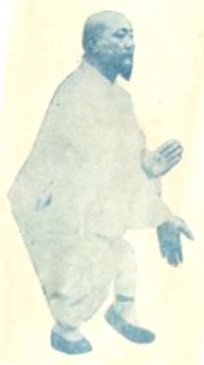
(二十九)扇通背(圖二十四)
29. FAN THROUGH THE BACK (photo 25):

(三十)撇身捶(圖二十五)
30. TORSO-FLUNG PUNCH (photo 26):

(三十一)卸步搬欄捶(圖十四)
31. WITHDRAWING STEP, PARRY, BLOCK, PUNCH (same as in photos 14 & 15)
(三十二)上勢攬雀尾(圖四)
32. STEP FORWARD, CATCH THE SPARROW BY THE TAIL (same as in photos 4 & 5)
(三十三)單鞭(圖六)
33. SINGLE WHIP (same as in photo 6)
(三十四)雲手一(圖二十六)
34. CLOUDING HANDS – Part 1 (photo 27):

(三十五)雲手二(圖二十七)
35. CLOUDING HANDS – Part 2 (photo 28):
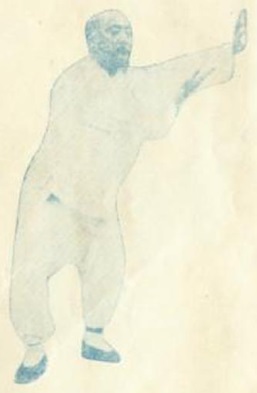
(三十六)高探馬(左) (圖二十八)
36. RISING UP AND REACHING OUT TO THE HORSE – Left (photo 29):

(三十七)分脚(右) (圖二十九)
37. KICK TO THE SIDE – Right (photo 30):

(三十八)高探馬(右) (圖三十)
38. RISING UP AND REACHING OUT TO THE HORSE – Right (photo 31):

(三十九)分脚(左) (圖三十一)
39. KICK TO THE SIDE – Left (photo 32):
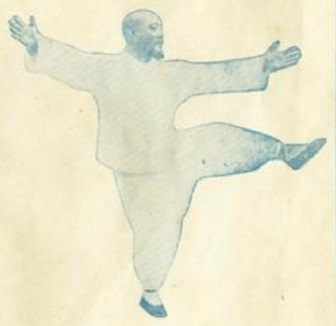
(四十)轉身蹬脚一(圖三十二)
40. TURN AROUND, PRESSING KICK – Part 1 (no photo)
(四十一)轉身蹬脚二(圖三十三)
41. TURN AROUND, PRESSING KICK – Part 2 (photo 33):
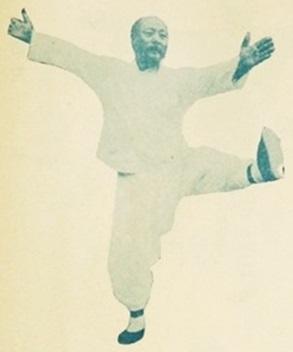
(四十二)進步栽捶(圖三十四)
42. ADVANCE, PLANTING PUNCH (photo 34):

(四十三)翻身撇身捶(圖二十五)
43. TURN AROUND, TORSO-FLUNG PUNCH (same as in photo 25)
(四十四)翻身二起脚一(圖三十五)
44. TURN AROUND, DOUBLE KICK – Part 1 (no photo)
(四十五)翻身二起脚二(圖三十六)
45. TURN AROUND, DOUBLE KICK – Part 2 (photo 35):

(四十六)雙峯貫耳一(圖三十七)
46. DOUBLE PEAKS THROUGH THE EARS – Part 1 (no photo)
(四十七)雙峯貫耳二(圖三十八)
47. DOUBLE PEAKS THROUGH THE EARS – Part 2 (photo 36):

(四十八)披身踢脚(圖三十五)
48. DRAPING THE BODY, KICK (photo 37 [& photo 33]):

(四十九)轉身蹬脚(圖三十三)
49. TURN AROUND, PRESSING KICK (photo 38 [& photo 35]):

(五十)上步搬欄捶(圖十五)
50. STEP FORWARD, PARRY, BLOCK, PUNCH (same as in photo 15)
(五十一)如封似閉(圖十六)
51. SEALING SHUT (same as in photo 16)
(五十二)抱虎歸山(圖十七)
52. CAPTURE THE TIGER AND SEND IT BACK TO ITS MOUNTAIN (same as in photo 17)
(五十三)摟膝拗步(圖十一)
53. BRUSH KNEE IN A CROSSED STANCE (same as in photos 11 & 12)
(五十四)攬雀尾(圖三)
54. CATCH THE SPARROW BY THE TAIL (same as in photos 3–5)
(五十五)斜單鞭(圖二十)
55. DIAGONAL SINGLE WHIP (same as in photo 20)
(五十六)野馬分鬃(左一)(圖三十九)
56. WILD HORSE VEERS ITS MANE TO THE LEFT – Part 1 (photo 39):
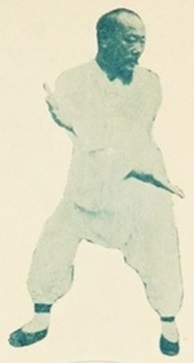
(五十七)野馬分鬃(左二)(圖四十)
57. WILD HORSE VEERS ITS MANE TO THE LEFT – Part 2 (photo 40):

(五十八)野馬分鬃(右一)(圖四十一)
58. WILD HORSE VEERS ITS MANE TO THE RIGHT – Part 1 (photo 41):

(五十九)野馬分鬃(右二)(圖四十二)
59. WILD HORSE VEERS ITS MANE TO THE RIGHT – Part 2 (photo 42):

(六十)玉女穿梭(左)(圖四十三)
60. MAIDEN WORKS THE SHUTTLE – Left (photo 43):
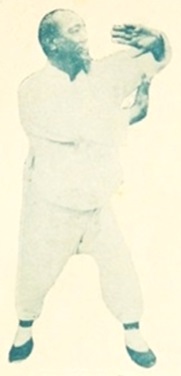
(六十一)玉女穿梭(右)(圖四十四)
61. MAIDEN WORKS THE SHUTTLE – Right (photo 44):

(六十二)單鞭(圖六)
62. SINGLE WHIP (same as in photo 6)
(六十三)雲手(圖二十六)
63. CLOUDING HANDS (same as in photos 26 & 27)
(六十四)下勢(圖四十五)
64. LOW POSTURE (photo 45):

(六十五)金鷄獨立(圖四十六)
65. GOLDEN ROOSTER STANDS ON ONE LEG (photo 46):

(六十六)倒輦猴(圖二十)
66. RETREAT, DRIVING AWAY THE MONKEY (same as in photos 21 & 22)
(六十七)斜飛勢(圖二十二)
67. DIAGONAL FLYING POSTURE (same as in photo 23)
(六十八)提手上勢(圖七)
68. RAISE THE HAND (same as in photos 7 & 8)
(六十九)白鶴亮翅(圖十)
69. WHITE CRANE SHOWS ITS WINGS (same as in photos 9 & 10)
(七十)摟膝拗步(圖十一)
70. BRUSH KNEE IN A CROSSED STANCE (same as in photo 11)
(七十一)海底針(圖二十三)
71. NEEDLE UNDER THE SEA (same as in photo 24)
(七十二)扇通背(圖二十四)
72. FAN THROUGH THE BACK (same as in photo 25)
(七十三)進步搬欄捶(圖十五)
73. ADVANCE, PARRY, BLOCK, PUNCH (same as in photos 14 & 15)
(七十四)上勢攬雀尾(圖四)
74. STEP FORWARD, CATCH THE SPARROW BY THE TAIL (same as in photos 4 & 5)
(七十五)單鞭(圖六)
75. SINGLE WHIP (same as in photo 6)
(七十六)雲手(圖二十六)
76. CLOUDING HANDS (same as in photos 27 & 28)
(七十七)高探馬(圖二十八)
77. RISING UP AND REACHING OUT TO THE HORSE (same as in photo 29)
(七十八)迎面掌(圖四十七)
78. PALM STRIKE TO THE FACE (photo 47):
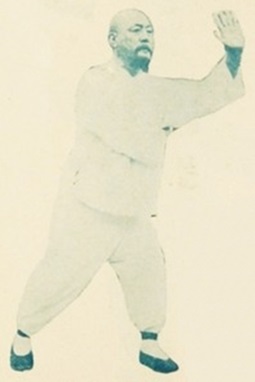
(七十九)十字擺蓮(圖四十八)
79. CROSSED-BODY SWINGING LOTUS KICK (photo 48):

(八十)摟膝指𦡁捶(圖四十九)
80. BRUSH KNEE, PUNCH TO THE CROTCH (photo 49):

(八十一)上勢攬雀尾(圖四)
81. STEP FORWARD, CATCH THE SPARROW BY THE TAIL (same as in photos 4 & 5)
(八十二)單鞭(圖六)
82. SINGLE WHIP (same as in photo 6)
(八十三)下勢(圖四十五)
83. LOW POSTURE (same as in photo 45)
(八十四)上步七星(圖五十)
84. STEP FORWARD WITH THE BIG DIPPER (photo 50):
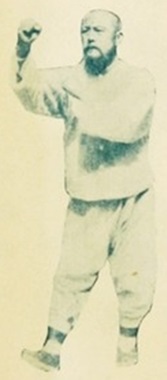
(八十五)退步跨虎〔(上)(下)〕(圖五十一)
85. RETREAT TO SITTING TIGER POSTURE – parts 1 & 2 (photos 51 & 52):


(八十六)轉脚擺蓮(圖五十二)
86. SPIN AROUND ON THE FOOT, SWINGING LOTUS KICK (photo 53):

(八十七)彎弓射虎(圖五十三)
87. BEND THE BOW, SHOOT THE TIGER (photo 54):

(八十八)上步高探馬(圖三十)
88. STEP FORWARD, RISING UP AND REACHING OUT TO THE HORSE (same as in photo 29)
(八十九)迎面掌(圖四十七)
89. PALM STRIKE TO THE FACE (same as in photo 47)
(九十)翻身撇身捶(圖二十五)
90. TURN AROUND, TORSO-FLUNG PUNCH (same as in photo 26)
(九十一)上步高探馬(圖二十八)
91. STEP FORWARD, RISING UP AND REACHING OUT TO THE HORSE (same as in photo 31)
(九十二)上步攬雀尾(圖四)
92. STEP FORWARD, CATCH THE SPARROW BY THE TAIL (same as in photos 4 & 5)
(九十三)合太極(圖一)
93. CLOSING POSTURE (same as in photo 1)
–
太極拳推手器械之說明 實行國術科學化 褚民誼
EXPLANATION OF TAIJI BOXING PUSHING HANDS APPARATUS – IMPLEMENTING THE SCIENTIZATION OF CHINESE MARTIAL ARTS by Chu Minyi
拳術所以活動筋骨。鍛鍊身心也。而太極拳則能修養身心。調和氣血。陶冶性情。郤病延年。演習旣久。趣味濃厚。故尤為拳術中之上乘。且其動作緩和。姿勢平順。語其功用。則能以靜制動。以柔克剛。以輕勝重。以順避害。故余嗜之成癖。無間寒暑。每晨必練數次。惟欲求拳術之精進。須演習推手。而推手非兩人演習不可。蓋欲使全身之感覺靈敏。而不即不離。發生黏勁。功效始著。顧余一人旣未能推手。則不得不謀一代替之方。思考所及。爰根據科學的原理。製成推手之器械兩種。一棍一球。以代替推手。而實行國術科學化。是二物也。對於推手中之八勢(掤捋擠按採挒肘靠)皆能一一運用適合。且不即不離。與推手無異。發明以來。蒙中外體育家拳術家之來參觀者。皆驚奇不置。茲將其構造說明如下。
Boxing arts exercise the muscles and bones, and train both body and mind. Taiji Boxing is able to cultivate body and mind, regulate energy and blood, mold the temperament, and to prevent illness and prolong life. If you practice it for a long time, your delight will only deepen, making it the “great vehicle” among boxing arts. Its movements are mild and its postures are agreeable. As for its applicability, it is able to use stillness to conquer motion, softness to overcome hardness, lightness to defeat heaviness, and smoothness to evade harm. Therefore I am devotedly addicted to it, compelled to practice it every morning even during the worst of winter or summer.
However, if you want to progress in your boxing art, you must practice pushing hands, and pushing hands cannot be practiced unless there are two people. Because the goal is to give one’s whole body a keen sensitivity, there is a quality of neither connecting nor disconnecting, generating “sticking” energy, and results will then manifest. As I myself have often been unable to do any pushing hands, I have had to come up with something to substitute it. After much pondering according to scientific principles, I have produced two kinds of pushing hands apparatus, one with a stick and one with a ball, to take the place of pushing hands.
With these items begins the scientization of Chinese martial arts. As for the eight techniques of pushing hands (warding off, rolling back, press, pushing, plucking, rending, elbowing, and bumping), they can all be applied perfectly well, and with that element of neither connecting nor disconnecting, the same as in pushing hands. Since inventing them, I have received visits from both Chinese and foreign physical educators and boxing arts experts, who have all been amazed beyond words. The basic construction is explained below:
{棍}
Stick:
先製成一能自轉之棍。而以橡皮帶八根之一端分繫於棍軸之兩頭。其他端則繫於一小室中之八角。或設一立方形木架。如是棍得八根據皮帶之平均牽制。乃懸於室之當中。苟有一力破其均勢。則隨其力之方向為轉移。力退則其均勢復成。故無論力之從上下左右前後。發生種種動作。皆能運轉自如。故推手中之八勢。亦能一一依法表演。而運動者立於棍之前後演習。與兩人之推手無殊焉。
First I had a stick made that can revolve on an axis [i.e. a hollow tube surrounding a rod], both ends of which are attached to eight strips of rubber, and the strips are then fastened to the eight corners of a small room, or to a cube-shaped wooden frame [as in the photos]. In this way, the stick is kept level by the eight pieces of rubber and is suspended in the middle of the space. If a force affects its equilibrium, it will shift along the direction of that force. When the force withdraws, the equilibrium is regained. Thus whatever direction the force comes from – up, down, left, right, forward, back – it generates a variety of movement and the movements can all happen smoothly. Hence the eight techniques within pushing hands can each be performed accordingly as one practices the movements going back and forth with the stick, hardly any different from two people pushing hands.
太極棍圖
Taiji stick:
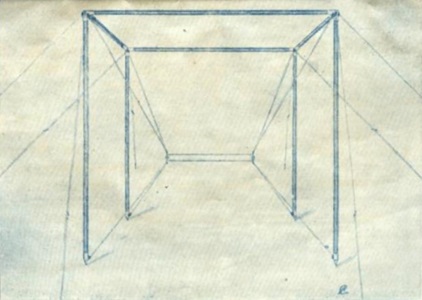
太極棍運用式一
A posture of using the Taiji stick:
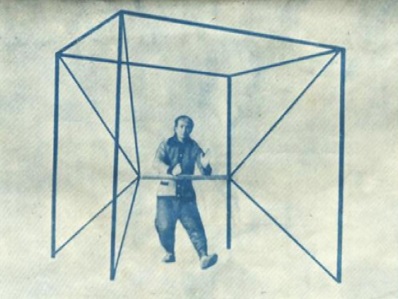
太極棍運用式二
Another posture of using the Taiji stick:
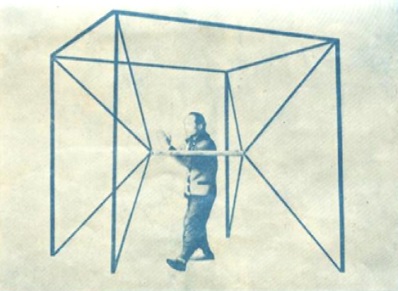
{球}
Ball:
球之直徑為中國尺一尺半。重十八斤。以銅為之而塗以鎳。以橡皮帶懸之於空中。球之高低則與人胸平。因繫以橡皮帶故。一遇外力之來。則亦隨其力之方向而動。上下左右前後。皆能圓轉如人意。而人立於球之前或後。作種種太極拳姿勢。亦能得心應手。其於推手中之八勢。亦可一一表演而出。故有以上二物。雖一人獨居練習。而於太極拳之精奧。已能依次漸進。不可謂非太極拳科學化之工具也。
The ball’s diameter is one and a half feet, and its weight is about twenty pounds. It is a brass shell with a nickel coating. It hangs in the air from a rubber strip at the height of a person’s chest. Because it is fastened by a rubber strip, when it encounters an outside force, it will move in the direction of that force – up, down, left, right, forward, or back – and so it can always be turned as you please. Standing in front of or behind the ball, you will be able to execute the various Taiji Boxing postures with great proficiency. As for the eight techniques within pushing hands, they can all be performed, and so it is as though there are two people, even though only one person is practicing. As the refined subtleties of the art can be gradually honed by this means, it is indeed to be considered a scientific tool for training in Taiji Boxing.
太極球圖
Taiji ball:

太極球運用式一
A posture of using the Taiji ball:

太極球運用式二
Another posture of using the Taiji ball:

以上二種器械。為不佞運用科學上之智識結構而成。此種小小發明。誠不敢謂於吾國國術上有所裨補。然吾人提倡國術之旨趣。則確在使其能科學化。所謂科學化者。在求國術之能適合於力學與心理學。講求生理與衞生而已。太極拳之能以輕勝重。以柔克剛。固已知運用心理學。而已參透力學之三昧。至其姿勢平穩。動作緩和。不偏不激。無過無不及。非講求生理與衞生而何。是故雖謂太極拳為業經科學化之國術。亦無不可。然則吾人提倡國術。不當自太極拳始耶。此不佞之所以制此器械。區區之意。在求其能普及。俾練習者。稍獲便益。使成為吾國國術科學化之嚆矢云爾。
I constructed the two types of apparatus above using scientific knowledge. They are rather minor inventions and I would not presume to say they are of great advantage to our nation’s martial arts, but for our purpose of promoting martial arts, they would indeed cause them to be more scientific. When we describe these arts as being scientific, we mean that we seek to make them more able to conform to mechanics and psychology, and with particular attention to physiology and health.
Taiji Boxing’s ability is to use lightness to defeat heaviness, softness to overcome hardness. Therefore it already knows how to make use of psychology and has a thorough understanding of mechanics. Its postures are stable, its movements relaxed, it is neither stubborn nor fierce, and it does not do too much, always just enough. Thus it does not need to give extra attention to physiology and health, and even though we hereby proclaim Taiji Boxing to be a scientific martial art, it always has been anyway.
That being the case, in our promoting of martial arts, is it not appropriate to begin with Taiji Boxing? This is why I made these types of apparatus. My aim is to be able to popularize them so that practitioners may get some benefit from them, and also to herald the scientization of our nation’s martial arts.
– – –
The introduction of these training tools at the end of Taiji Boxing Photographed cries out for further information. Chu elaborates upon his inventions, including describing actual exercises, in Appendices 1, 2, 7, and 8 of his Taiji Calisthenics (published Aug, 1931):
對於太極拳信仰益堅。每日習練更勤。不過盤架子以後。想繼以推手。往往因一人無法解決。以是便有推手器械之發明。以代對手者。
發明推手器械的動機。是在北平時。由譚仲逵先生予以線索。因在譚先生介紹吳先生於我的時候。他於太極拳已非常純熟。惜後來不繼續習練。至今反多曠廢。他給我些什麼線索。就是他偶爾談及。說日後或可用器械以練習此拳。當時我因初入其門。不能理會。去年赴歐考察衞生。在舟中仍日日習練。並且教會了一位同舟的陳宗城先生。(他是國際勞工局秘書。未審渠現猶習之否。)
那時余於舟上獨自耍拳舞劍。但終沒有推手的機會。有時偶立船旁。兩手磨擦欄杆。宛似作推手動作。便幻想如欄杆能旋轉圓活。並得上下左右。不是很好嗎。因根據這個理想。便有推手棍之發明。棍之構造。先製一能自旋轉之木棍。每端繫以橡皮帶凡四。懸之使成均勢。每端的四根橡皮帶。宛似我們眼睛的上下左右四條肌肉。有此四條肌肉的牽制。眼能左右上下。旋轉裕如。棍之繫以橡皮帶。也與此有同樣的作用。至於太極球呢。則脫胎於中國昔日所用的沙袋。不過從前的沙袋是擊之以拳。今我所發明的太極球。則運用手臂肩胸背之力。去推盤的。沙袋是以繩懸之於空中。而太極球則凌空懸以橡皮帶。帶有彈性。隨人推動之方向為轉移。也能上下左右前後。得心應手。第三種推手器械。其構造則稍覺簡單。這三種推手器械。雖屬利於推手。並練習旣久。亦能找出太極拳推手中十三勢之八卦。(掤捋擠按採挒肘靠)及五行。(進退顧盻停)但無論怎樣。我總認為不若人與人的推手那樣靈敏。因為推手器械。總是人為主動。物為被動。只要人力使之向何處。則器械亦隨之而去。而器械之反應是照着去的方向而回到對面而已。人與人的推手。則不但我為主意。人也有主意。我欲將人被動。有時人亦以我為被動。所以推手中之『聽勁。』器械上則易。人與人便難了。但是學習時。器械也是必不可少的良好助手。因萬事總是由易而難。先熟習易於聽勁的器械。後乃進一步習聽勁較難之人與人的推手。所以我發明這三種器械。拳術界的同道。都盛道其功用之偉。羣相贅歎。同時我自己也很珍視。並且想將這種器械推廣。以替代一切激烈和剛猛的運動。雖則激烈和剛猛的運動。也有它的長處。然而總利不敵弊。得不償失。如這三種器械性質。温和柔軟。運用之有益無損。就是很衰弱很龍鍾的人。也得演習。這是它最大的長處。不若別種專供少壯人的賞鑑。邇來我在三種太極拳推手器械上。每日演習的時間。要占十分鐘多至半時或一時。覺得進步很神速。所以極願意介紹給一般未學太極拳者。亦得據以演習。鍛練筋骨。減少疾苦。來增進他們健康和幸福。
I believe there is great benefit to be gained from Taiji Boxing, and so I practice diligently every day. But after going through the solo set, I then feel like doing some pushing hands, and because there is often no one to practice with, I have thus invented a variety of pushing hands apparatus to take the place of a partner. I was motivated to invent them while in Beijing. It was Tan Zhongkui who set me on that path, through whom I met Wu Jianquan. Tan was very skillful in Taiji Boxing, though unfortunately he later did not continue in his training, and so now it has all gone to waste. But he happened to give me some clues during moments of our conversations, in which he explained that there might someday be machines used for practicing this boxing art. Because I was a beginner at the time, I was incapable of comprehending this idea.
Last year I went Europe to observe their health practices, and I practiced every day while on the boat, even teaching my fellow passenger Chen Zongcheng. (He is the Secretary of the International Labor Department, though I do not know if he is still practicing what I taught him.) At that time, I ran through the boxing and sword sets alone on the boat, but I never had any opportunity to do any pushing hands. Sometimes I would stand at the side of the boat and rub my hands along the railing, in the manner of pushing motions, imagining that the railing could roll and circle. I would move upward and downward, to the left and right, but it was not very effective. On the basis of this, I got the idea of and subsequently invented the pushing hands stick.
For the construction of it, first I had a wooden stick made that can revolve on an axis, then attached each end to four rubber strips for it to hang balanced. These four rubber strips are just like the four muscles of the eyes which move them up, down, left, right. Through the control of these four muscles, the eye is able to roll around, and the stick fastened to its rubber strips functions in the same way.
As for the Taiji ball, it was born of the sandbags used in old China. Although they were used as punching bags, the Taiji ball I have invented is to be pushed around by the force of the hands, arms, shoulders, chest, and back. The sandbag was suspended in the air by a rope, but the Taiji ball is suspended by a rubber strip, lending it a springiness so that it shifts along the direction of the person’s push, able to move up or down, left or right, forward or back, with great ease.
There is also a third kind of pushing hands apparatus which is of a somewhat simpler construction [presumably referring to the smaller ball set atop a pole – see further below].
These three kinds of apparatus will enhance pushing hands, and after practicing with them for a long time, you will be able to discover all of the thirteen dynamics: the eight techniques (warding off, rolling back, press, pushing, plucking, rending, elbowing, and bumping) and the five steps (advancing, retreating, stepping to the left, stepping to the right, and staying centered).
Whichever is used, I always believe they do not compare to the sensitivity between two people pushing hands, because when using an apparatus, the person is always initiating and the object is always passive, merely going wherever the person’s force sends it, complyingly going away and then correspondingly returning. When pushing hands with a partner, it is not only my intention that is involved, but also the other person’s. I want to put him in the passive role, but sometimes he likewise puts me in the passive role. Therefore pushing hands contains “listening” to energy. Working with an apparatus is easy, whereas working with a partner is more difficult. However, in the course of learning these things, such types of apparatus are an indispensable aide. This is because everything is a process of going from the easy to the difficult. Start by becoming skillful at the easier task of listening to the energy of an apparatus, then progress to the more difficult task of developing listening while pushing hands with a partner.
Similar ideas to my inventions have been thought of in the world of boxing arts, which is filled with grand methods of training, and many might feel these are among the more superfluous, yet I personally find them to be quite a treasure. I hope to popularize them, and that they may become a substitute for more intense and vigorous forms of exercise. Although such activities also have their good points, their benefits do not outweigh their harms, and so they are not worth the effort.
These three kinds of apparatus have a mild and gentle quality, and so using them will be only beneficial and not harmful at all. Even weak and enfeebled people can use them for exercise. This is the greatest of their good points, the fact that they not things that could be appreciated by only the young and tough. I have so far practiced with these kinds of apparatus every day for ten to thirty minutes, sometimes a full hour, and have felt amazingly fast progress. Thus I am very willing to recommend them to ordinary people who have not yet studied Taiji Boxing. Such practice builds up the physique and dispels bodily suffering, enhancing health and happiness.
–
太極拳推手棍之演習法 褚民誼
TRAINING METHODS FOR THE TAIJI BOXING PUSHING HANDS STICK
1 練手
Training the hand:
人立於棍前。面東背西。坐身於右腿上。左足向前足跟着地。將左手平放於棍上。手背朝天。(見圖一)
Stand in front of the stick, facing to the east, back to the west. Sit your body onto your right leg, your left foot forward, heel touching down. Put your left hand flat on top of the stick, the back of the hand facing upward. See photo 1 [left and right reversed in the photo]:

由左手將棍推動。先向東進轉南。而西至北。使成一環形。惟屬於平面的環形。數次以後。便一反其動作。坐身於左腿上。右足向前足跟着地。將右手平放於棍上。先手背朝天。手掌貼棍。由右手將棍推動。先向東轉北。而西至南。亦成一平面的環形。然後手掌朝天。手背貼棍。此為置手於棍上之第一式。第二個方式呢。手足之放置。及身之坐勢。一似第一式。惟推動時。用左手。則左手先向上轉南。向下轉北。用右手則右手先向上轉北。向下轉南。使成一橫的環形。第三個方式。手足坐勢亦一仍其舊。惟推動時手先向上轉東。向下轉西。或變為向上轉西。向下轉東。使成一縱的環形。以上三種方式。成為三個環形。(一)平面的環形。(二)橫面的環形。(三)縱面的環形。同時共有六個方向。上,下,東,(前)南,(左)西,(後)北。(右)三個環形相倂。便形成一個球體。不過以上所說的。都是用左手時。則身坐於右腿。用右手時。則身坐於左腿。習之旣久。便能隨意更換。就是用左手時亦可坐身於左腿。用右手時。也能坐身於右腿。單手的動作習慣後。進而以兩手推動。也作三個環形。變換六個方向。坐身於腿亦可任意左右。這樣手在棍上的演習純熟後。更可以將手棍易位而處。置手於棍下。先手背向地。手掌貼棍。然後手背貼棍。手心向地。坐勢在左腿或右腿。亦隨意更換。推動時也作三個環形。六個方向。如是則手可忽居棍上。忽伏棍下。隨意掀上翻下。由單純而複雜。由遲緩而敏捷。驟視之。手棍如相黏貼。不卽不離。不頂不丟。鎔在一處。
Your left hand pushes out the stick, moving it first to the east, then to the south, then west, then north, making a flat circle. After several of these circles, switch sides. Sit your body onto your left leg, your right foot forward, heel touching down, and put your right hand flat on top of the stick, the back of the hand facing upward [as in the photo]. With the palm touching the stick, your right hand pushes out the stick, moving it first to the east, then to the north, then west, then south, again making a flat circle. Then perform the exercise with the palm facing upward so the back of the hand is touching the stick. This is the first exercise for the hand.
The second exercise is the same as the first for the hand, foot, and body placement, but the movement instead goes: up, south, down, north – for the left hand – or up, north, down, south – for the right hand – making a crosswise circle.
The third exercise is still the same as the first for the hand, foot, and body placement, but the movement goes [for either hand]: up, east, down, west – or can be switched to up, west, down, east – making a vertical circle.
These three exercises make circles on three different planes: 1 – flat [parallel with the ground], 2 – crosswise [like washing a window], 3 – vertical [like turning an organ grinder]. They therefore travel to a total of six directions: up, down, east (forward), south (right), west (rear), north (left). The three circles together form a sphere.
However, as described above, you would always be sitting your body onto your right leg when using your left hand and onto your left leg when using your right hand. After practicing for a long time, you will be able to switch as you please, and then when using your left hand, you may sit onto your left leg, or when using your right hand, you may sit onto your right leg.
After you are accustomed to doing the exercise with a single hand, progress to do the pushing movements with two hands, making all three circles, moving in all six directions, sitting your body onto either leg.
Once you are skillful in these exercises involving the hand being on top of the stick, you can then change the hand position and put your hand under the stick. Begin with the back of the hand facing the ground, the palm touching the stick, then move on to the back of the hand touching the stick, the palm facing the ground. Sitting onto either leg, switching movements as you please, do the pushing exercises, all three circles, all six directions. In this way, your hand can be suddenly on top of or under the stick, switching easily back and forth. Going from the simple to the complex, from slow to quick, it will at some point seem as though hand and stick are stuck together, without either pressure or separation, without crashing against each other or coming away, fused into one.
2 練腕(俗稱小臂)
Training the wrist area (i.e. the forearm):
人立於棍前。面東背西。坐身於右腿上。左脚向前。脚跟着地。將左腕平放於棍上。手掌向下。由左腕將棍推動。先向東進轉南。而西而北。使成一平面的環形。同時也更換右腕。而和練手的方法一樣。作三種方式。使成三個環形。六個方向。餘可類推。腕在棍上時。則手掌向下。腕在棍下時。則手掌向上。而腕因手心的更換其方向。使得轉輾圓活。一似車軸。同時置腕於棍上時。手掌亦可忽向上忽向下。於棍下時亦然。譬如平置左腕於棍上。手掌向下。先向東推轉南。手及腕已側置於棍上。手掌向南。由南而西時。手掌向上。及至北面時。則手掌又向下。腕亦向下。反之。則手掌向下之左腕。先由東推轉北。手掌亦向北。由北而西時。手及腕亦已側置於棍上。手掌向南。及至南面時。則手掌向上。腕亦向上。及由南至東時。則腕成向內轉之勢。手掌向下。以復原狀。這是專指左腕而言。若右腕練習。則更換推動方向便得。其餘便不難類推了。
Stand in front of the stick, facing to the east, back to the west. Sit your body onto your right leg, your left foot forward, heel touching down. Put your left hand flat on top of the stick, palm facing downward. Your left hand pushes out the stick, moving it first to the east, then to the south, then west, then north, making a flat circle. Then switch to the right wrist, same practice method as for the right hand, and perform all three exercises, making all three circles, moving in all six directions, and the rest you can intuit by analogy [with the exercises for the hand].
When the wrist is on top of the stick, the palm is facing downward. When the wrist is under the stick, the palm is facing upward. Then by changing the direction the palm is facing, the movements are livened, like the hand is twisting on an axle. With the wrist on top of the stick, the palm can suddenly face upward or downward, likewise when under the stick.
For example, put your left wrist on top of the stick, palm facing downward, and begin by pushing out to the east and moving to the south, your hand and wrist now placed sideways on top of the stick, the palm facing to the south. As you then go from the south to the west, the palm faces upward, and upon reaching the north, the palm is again turned over to face downward, as is the wrist.
To reverse the circle, the palm faces downward, and begin by pushing out to the east and moving to the north, the palm also facing to the north. As you then go from the south to the west, your hand and wrist are again placed sideways on top of the stick, the palm facing to the south, and upon reaching the south, the palm is turned over to face upward, as is the wrist. Then when going from the south to the east, the wrist arcs inward for the palm to face downward, restoring your original position.
This description has focused on the left wrist. To practice with the right wrist, simply reverse the directions. It is not difficult to reason out the rest by analogy.
3 練臂(自肩至腕俗稱大臂)
Training the whole arm (i.e. from the shoulder to the wrist)
臂的練習法。與上說無異。不再贅述。惟練習不若腕之易耳。
The methods for practicing with the arm are no different from the explanations above, and so it is not necessary to repeat them, though they do not include the same [twisting] changes as with the wrist.
以上所述之三種。練習時則界限分淸。不容混亂。就是說。練手時。則專見手和棍發生關係。練腕或臂時。則專見腕或臂和棍發生關係。但是同時亦得合倂動作。就是推動時。手腕臂一齊和棍摩擦。使上肢全部的筋骨及血液。均活動而流通。如此以皮膚與棍摩擦之法。一似中國之推拿及西洋之按摩術。因筋骨活動。使內體亦感受按摩功能。惟按摩術。需人為我摩擦。電摩機用電力為我摩擦。均屬被動。而此利用器械以摩擦。則屬自動。吾人屢見年事較高之人。恆因筋骨不舒。感覺酸痛。需倩人為之搥背按胸等等。是卽因在壯年時未曾注意及運動。故始需要此種人力或電力之被動按摩。推手棍不但能運動吾人手臂。且背腰胸脅均能賴以運動而舒展之。今再分段言之。
The three kinds of exercises described above should be practiced distinctly in order to prevent confusion. In other words, when training the hand, focus on the relationship between the hand and the stick, when training the wrist, focus on the relationship between wrist and stick, and when training the arm, between arm and stick. And yet at the same time, the exercises are merged in the sense that when you are doing these pushing movements, your hand, wrist, and arm are rubbing against the stick equally, causing in the upper limbs better livening of the tissues and circulation of the blood. In this manner of the skin being rubbed against the stick, it is like techniques of Chinese tuina or Western massage, because as the muscles and bones are getting livened, the inside of the body receives the effects of being massaged.
However, massage techniques involve a person being rubbed by another person or by an electric machine, both a passive experience, whereas this is a massage involving an apparatus that is an active experience. We often witness people older than ourselves with constant discomfort in their muscles and bones, who are always aching and need to ask others to pound their backs, press their chests, and so on. This is because they did not pay attention to exercise when they were in the prime of life, and hence have become dependent on this kind of passive massage from other people or electric devices. The pushing hands stick can not only exercise our hands and arms, but can also work the back, waist, chest, and ribs, as described below:
4 練背
Training the back:
人背棍而立。背與棍相接。坐身於左腿或右腿。左足或右足向前。足跟着地。身稍前傾。作鞠躬狀。棍卽緣背上駛。胸向前挺。棍卽下降。(見圖二)
Stand with your back to the stick, back and stick touching. Sit your body onto your left leg or right, the opposite foot forward, heel touching down. Lean your body forward, in the manner of drawing a bow, which causes the stick to move upward along your back, then stick out your chest, causing the stick to move downward. See photo 2:

此種演習。最含太極拳中涵胸拔背之用意。如是挺胸鞠背。棍卽上下徐馳不離。最初棍之上駛下馳。成一直線。久之能使棍由背左方上升。背之右方下降。或右方上升。左方下降。均可成一環形。因之腰亦藉以轉動。卽因身體左右側之故。更有一練背之法。身向前彎。曲背於棍下。背與棍成平行線。使背棍相接。張兩臂向左右擺動。使棍似車輪式轉輾於背之左右。
This kind of exercise conforms very much to the Taiji Boxing principle “contain your chest and pluck up your back”, and when you then stick out your chest and arch your back, the stick will move up and down without disconnecting whether you move slowly or quickly. At first, the stick will move up and down more quickly and in only a straight line, but after a long time you will be able to make the stick go from your back’s upper left to lower right, or from upper right to lower left, making a constant circle. Your waist goes along with the movement to twist your body to the left and right.
Another method is to bend forward until your back is under the stick, so that back and stick are parallel with each other while touching. Extend your arms and sway them to each side, making the stick roll over your back to the left and right.
5 練腰脅
Training the waist and ribs:
身側立於棍旁。置棍於左脅下。坐身於左腿上。右足向前。足跟着地。身向右傾。棍卽緣左脅而上。轉向左傾。棍卽下落。置棍於右脅下時。坐身於右腿上。左足向前。足跟着地。身向左傾。棍卽緣右脅而上。轉向右傾。棍卽下落。練左脅時亦可坐身於右腿。練右脅時。亦可坐身於左腿。如是則棍之所至。腰脅均受其摩擦。
With your body sideways, stand next to the stick.
When the stick is placed under your left ribs, sit your body onto your left leg with your right foot forward, heel touching down. Lean your body to the right, causing the stick to go upward along your left ribs, then switch to leaning to the left, bringing the stick back down.
When the stick is placed under your right ribs, sit your body onto your right leg with your left foot forward, heel touching down. Lean your body to the left, causing the stick to go upward along your right ribs, then switch to leaning to the right, bringing the stick back down.
When training your left ribs, you can also sit your body onto your right leg. When training your right ribs, you can also sit your body onto your left leg.
By this means, wherever the stick goes, your waist and ribs are receiving a massage.
6 練胸
Training the chest:
人向棍立。胸與棍相緊貼。先坐身於左腿。胸向前彎。棍卽向下。胸向後傾。棍卽向上。同時亦得坐身於右腿。更須將胸部作左右側轉。則棍得由左上而右下。或右上而左下。亦成一環形。腰亦隨胸之左右側而旋轉。更有一動作於練胸或背時。坐身於兩腿上。成太極拳之單鞭勢。亦合乎涵胸拔背之意。
Stand facing the stick, connecting at your chest. Start by sitting your body onto your left leg, bending your chest forward, making the stick go downward, and lean your chest back, causing the stick to go upward as you sit onto your right leg. Then you must send your chest twisting to the left and right, making the stick go from the upper left to the lower right, and from upper right to lower left, again making a circular shape, your waist turning along with the twisting of your chest.
There is also a version when training your chest or back in which you sit your body onto both legs equally, making Taiji Boxing’s SINGLE WHIP posture.
These exercises merge with the principle of “contain your chest and pluck up your back”.
–
太極拳推手球之演習法 褚民誼
TRAINING METHODS FOR THE TAIJI BOXING PUSHING HANDS BALL

(甲)練單臂
A. Single-arm training
1 人面球而向東立。坐身於左腿。左脚向前。脚跟着地。右肱及手均貼於球側。手作撫球狀。徐舉向上置於球頂。繼向北而下。成一橫的環形。手於向上時。則手心貼球。由上而北時。則手背貼於球側。及至球下時。則手向外轉。手心又貼於球底。如是數次以後。可以換一方向。手肱由北向上。手背貼球。手至球頂。則手肱側置球上。俟由南而下時。手向內轉。使手心貼球。如是又可數次。便可坐身於右腿。運用左手。其演習法一如右手。亦成橫的環形。練習熟諳後。也可練左手時。坐身於左腿。練右手時。坐身於右腿。
Stand in front of the ball, facing to the east. Sit your body onto your left leg, your left [right] foot forward, heel touching down. Your right hand and forearm touch the side of the ball. Your hand seems to stroke along the ball as it slowly raises up until on top of the ball, then continues to the north and downward, making a crosswise circle. When your hand is on top, the palm is touching the ball. When going from above to the north, the back of the hand is touching the side of the ball. Once under the ball, the hand has turned outward so the palm is again touching.
After doing it in this way several times, you can reverse the direction, the hand and forearm going upward from the north, the back of the hand touching the ball. Once the hand is on top of the ball, the forearm is placed sideways on it, and then once it has gone downward from the south, the hand has turned inward, causing the palm to be touching.
Then after doing it in this way several times, you can sit onto your right leg and exercise your left hand. The practice method is the same as for the right hand, also making a crosswise circle. Once you have become skillful at this exercise, you can also practice with your left hand while sitting on your left leg, and practice with your right hand while sitting on your right leg.
2 人面球而向東立。坐身於左腿。右脚向前。脚跟着地。右手及肱亦貼於球側。作撫球狀。手徐徐由東向上。轉西而下。手肱總是貼於半球。成一縱的環形。數次以後。可以換一方向。就是由下而西。轉上而東。練左手時。也坐身於右腿。作兩個環形。和右手同樣。而亦得練左手坐身左腿。練右手坐身右腿。這都在乎習者的心領意會。
Stand in front of the ball, facing to the east. Sit your body onto your left leg, your right foot forward, heel touching down. Your right hand and forearm are again touching the side of the ball. Your hand seems to stroke along the ball as it slowly goes upward from the east, then to the west, and downward. Your hand and forearm are always touching a hemisphere, making a vertical circle. After several times, you can reverse the direction: to the west from below, then upward, and to the east.
When practicing with your left hand, sit onto your right leg, and make the same two circles as with your right hand. Again, you can also practice with your left hand while sitting on your left leg, and practice with your right hand while sitting on your right leg. These are all exercises you will understand intuitively.
3 人面球而向東立。坐身於左腿。右脚向前。脚跟着地。右手及肱貼於球底。手漸移向東至北。轉西至南。作一平面的環形。數次以後。也換一方向。由東而南。轉西至北。亦成一平面的環形。練左手時。則坐身於右腿。左脚向前。脚跟着地也根據以上的方向。作兩種平面的環形。同時亦得練左手坐身左腿。練右手坐身右腿。
Stand in front of the ball, facing to the east. Sit your body onto your left leg, your right foot forward, heel touching down. Your right hand and forearm are touching under the ball, and the hand gradually shifts around from the east to the north, then to the west, and to the south, making a flat circle. After several times, reverse the direction: from east to south, west, north, again making a flat circle.
When practicing with your left hand, sit onto your right leg, your left foot forward, heel touching down, same as before, making the same two flat circles. Again, you can also practice with your left hand while sitting on your left leg, and practice with your right hand while sitting on your right leg.
(乙)練雙臂
B. Double-arm training
1 人向球立面東。坐身於左腿。或右腿。左足或右足向前。足跟着地。兩手成一抱勢。將球懷抱。先由右肱及手做一縱面的環形。由上而西。轉下至東。在右手由上而西時。左肱及手遂由下而西。轉上至東。互作環形。
Stand in front of the ball, facing to the east. Sit your body onto either leg, the other foot forward, heel touching down. Your hands are in a posture of embracing, bringing the ball to your chest. Start by making a vertical circle with your right hand and forearm: up, west, down, east. While your right hand is going to the west from above, your left hand and forearm are also making a circle downward from the west, then upward to the east.
2 人立方向手足坐勢一似第一式。惟兩肱及手雖做兩個同樣的縱的環形。面方向各異。譬如左肱及手推動的方向。由上而東。轉下至西。而同時右肱及手推動的方向。由上而西。轉下至東。初練時頗不易。習之久便能純熟。因為我們的神經。要使兩手做各異方向的動作。異常困難。譬如右手握拳。左手平放。均置於桌上。要使握拳的右手。作擊桌狀。而平放的左手作摩擦狀。要同時而動作不同。已覺顧此失彼。不能如意。所以有猶豫而兩手都作擊桌狀。或兩手都作摩擦狀。這就因神經只能貫注於一處的緣故。但習練久後。則兩手亦可於同時很如意的為不同的動作。兩手在球之左右推動則易。而在球之上下則難。因球頂繫繩發生障礙。所以混合的演習式。一手可在球之左右推動使成縱或橫的環形。而一手則貼球底作平面的環形。練兩臂時坐身左右腿可隨意更換。身或向前。作攻勢。或向後。作坐勢。作攻勢者。身向前曲左膝。使左脚尖和左膝與鼻三點均在一直線上。而右腿向後挺直似撐屋之薦柱。這是左實右虛。作坐勢者。則坐身於右腿。左腿向前左脚跟着地。這是右實左虛。這樣因身之忽前忽後而腰亦運動矣。
The direction you are facing, the actions of your hands, and the shifting of the weight are all the same as for the first exercise, but although your hands and forearms are making the same kinds of vertical circles, they are now moving in slightly different directions from each other. For example, as your left hand pushes up, east, down, west, your right hand is pushing up, west, down, east. While this is quite difficult in the beginning of the training, you will be able to do this skillfully once you have been practicing for a long time. The problem is that our nervous system has to make our hands move in opposite directions, which is extremely difficult.
For an analogy, grasp your right hand into a fist, flatten out your left hand, and put them both onto a table. As you do this, try to strike it with your right fist as you rub it with your left hand. [The Western equivalent is of course patting your head while rubbing your tummy.] You have to perform different actions at the same time, which feels like too much to handle and impossible to do smoothly. You will consequently hesitate and end up striking with both hands or rubbing with both hands, and this is because the nervous system is only able to focus on one thing at a time. However, after practicing for a long time, your hands will be able to simultaneously and easily perform different movements.
For your hands to be pushing on the ball to the left and right is easy, but there is a difficulty in pushing upward and downward, and this is because the fastening on top of the ball may get in the way. Therefore the exercises are to be mixed, so that as one hand is pushing left or right in a vertical or crosswise circle, the other hand touches the ball underneath and makes a level circle.
While practicing with both arms, you may sit onto either leg and switch them as you please. Your body may be attacking forward or sitting back. Attacking forward, your body goes forward, your left knee bending, creating a line from toes to knee to nose, your right leg straightening behind and bracing like a pillar. The situation in this case is left foot full, right foot empty. Then sitting back onto your right leg, your left leg in front is touching down with only its heel. The situation in this case is right foot full, left foot empty. In this way, your body is going suddenly forward or suddenly back, and your waist is moving correspondingly.
練單臂之第一式練右臂時手心及肱緊貼於球之南。(卽側面)現置之於球南之對面。(卽北面)手背貼球。如是則球已居身之右。不與人相對矣。習左臂時亦然。推動時作兩個縱的環形。(一)由上而東轉下至西。(二)由上而西轉下至東。坐身於腿亦隨意更換。
When practicing the first single-arm exercise with your right arm, the palm and forearm are touching the south side of the ball, then touching the ball with the back of the hand once on the opposite side. In this way, the ball is to the right side of your body rather than directly in front of you. When practicing with your left arm, the situation will be the same [i.e. mirrored – the ball to the left side of your body, palm touching the north side, then back of the hand touching the south side]. During the pushing movement, make two vertical circles – 1. up, east, down, west, 2. up, west, down, east – sitting onto either leg and switching as you please.
旣球頂懸繩處無法練習。然球上之左角。和右角。便得利用。(練法)先坐身於右腿。置左肱於球之左角。手肱向前轉而向後縮。由上而西。轉下至東。在球角作一斜或縱橫參半的環形。這個環形亦得由上而東。轉下至西。亦有兩個方向。練習時。首宜注意。使手臂似車軸之轉輾。同時右肱亦可在右角同樣演習。坐身於左腿。或右腿均可。
The area on top of the ball where it is suspended cannot be used for practice, but the upper left and upper right corner areas can be used. To practice, first sit onto your right leg and place your left forearm forward on the upper left area of the ball, then withdraw to make a circle: to the west from above, below, and to the east. This makes a diagonal circle, halfway between a vertical circle and a crosswise circle. There is also the reverse circle: up, east, down, west. And thus you have both directions of the circle to practice.
When practicing, you should pay attention first of all that your arm seem like a wheel rotating on an axle. Then place your right forearm on the upper right area of the ball and practice the same exercise. And then practice while sitting onto either leg.
(丙)練肩
C. Training the upper arm
1 人向球立。面東。坐身於左腿。右足向前。足跟着地。右肩貼球。肩在球側。亦得由東而上。轉西而下。或由西而上。轉東而下。成兩個縱的環形。練右肩時。除坐勢更換外。其餘相當。然坐身於腿亦得或左或右。
Stand in front of the ball, facing to the east. Sit your body onto your left leg, your right foot forward, heel touching down. Your right shoulder touches the side of the ball and your upper arm circles east, up, west, down, and also west, up, east, down, making the two vertical circles. When practicing with the upper arm, everything is the same as with the forearm, and you may likewise switch onto either leg.
2 練肩時。得同時練臂及背。先將肩靠於球側。舉臂與肩平。肩稍向前則球卽旋轉至背部。肩往後退。球卽由背經肩而達臂側。成一靠勢。似太極拳勢中之野馬分鬆及斜飛式之類。如肩動稍劇。則球能由右肩全部至背。由背而轉至左肩。經左臂而至前方。如是球便繞人一週。一若月繞地球地球繞日的樣子。然要球更至後面則方法良多。最簡單的方法。球在前面時。用左臂作一橫的環形。至北時臂肩向球一靠。球又向後轉去。而至背部。
When practicing with your upper arm, you are simultaneously training your arm and your back. Start by leaning your shoulder against the side of the ball with your arm raised to shoulder level. As the tip of your shoulder goes forward, the ball rolls around to your back, and as your shoulder withdraws, the ball goes from your back, along your shoulder until on the side of your arm, making the “bump” posture. This is like the Taiji Boxing postures WILD HORSE VEERS ITS MANE or DIAGONAL FLYING POSTURE.
If your shoulder moves more forcefully, the ball can roll fully around your back to your left shoulder, and go along your left arm until again in front. In this way, the ball goes all the way around your body like the moon orbiting the Earth or the Earth orbiting the sun.
There are many methods of sending the ball behind you. For the simplest method, when the ball is in front of you, use your left arm to make a crosswise circle, and once the circle is to the north, lean your shoulder into the ball, rolling it around to your back.
還有一種逆來順受的方法。用手推球使球向前盪去。及球盪囘時。則胸向後迎受。使球乘虛而入。然後乘勢而推之向前。這也有涵胸拔背之意。
There is also a method to practice reversing incoming force. Push the ball with your hand to make the ball swing away. Then as the ball swings back, your chest goes to the rear to receive it, causing the ball go into an emptiness, then take advantage of the opportunity [i.e. when the pendulum swing reverses its momentum] and push it forward. Here again is the idea of “contain the chest and pluck up the back”.
–
太極拳手球
TAIJI BALL FOR EXERCISING THE HANDS
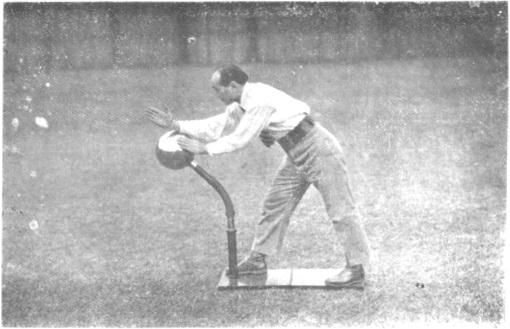
專運動手臂者。其構造為一直徑約八九寸之球。置一桿。裝有彈簧。竿上置球。立竿於平地或板上。人立一端。俯身以手或臂推球。球亦能旋轉四週。
To focus on exercising the hand and forearm, I have constructed a ball about nine inches wide, placed on the end of a shaft containing a spring, which is set atop a pole. The pole is stood on level ground or on a board. Stand on the end of the board, lean over, and use your hand or forearm to push the ball. The ball can also be revolved all the way around.
–
太極拳腿球
TAIJI BALL FOR EXERCISING THE LEGS

運動腰腿部者。則以竹或籐製成一直徑二尺餘之球。置於平地上。隨腰腿之推球藉以運動。
To exercise the hips and legs, there is a ball made of bamboo or rattan, around two feet in diameter, placed on the level ground, which is pushed around by the legs.
–
鬭球場
FIGHTING BALL ARENA

此外則有一鬭球場之發明。場為環形。架竹或木以成圈。為一盆子形。以無數小竿或木板斜倚其中。外高而內平。場中留有隙地。約一丈直徑。其邊為二丈半。故全場之直徑為六丈。人立其中。以手臂盤籐製三四尺直徑之球。球經推動。自必旋轉。順其勢而發動。球轉旋至場邊。邊高球仍下滾。以手臂或胸背腿接之。而又發出。於是以球為人。作種種鬭勢。待工夫純熟後。遇敵則以人為球矣。此種鬭球。一人練習須用此場。二三人或三四人練習。則用平地。因甲推球旋轉而發至乙。乙盤球而推至丙。如是多數人同時動作。可以運動全身。
I have also invented a “fighting ball arena”. The arena is round, a circular rack of bamboo or wood to make a basin shape, many thin poles or wood planks inclined toward the center. It goes higher to the outside and is level in the middle. The center of the arena is kept as an open space about ten feet across. From there to the edge is about twenty-five feet. Therefore the whole arena has a diameter of sixty feet.
Stand in the center and use your hands or forearms to roll the ball, made of rattan, three or four feet wide, pushing through it. It will roll naturally, going along with your momentum, as you send it away. The ball rolls to the edge of the arena, and once at the top, rolls back down. Connect to it with your hands, forearms, chest, back, or leg, and send it away again. Therefore the ball is like an opponent, and puts you into various fighting postures. And then once you are skillful at it, you can think of an opponent as being the ball.
For solo practice, this kind of “fighting ball” requires using the arena. When practicing with two, three, or four people, use level ground. Person A rolls the ball away to Person B, then Person B rolls the ball, pushing it to Person C. In this way, many people can take part at the same time. This activity can exercise the whole body.
– – –
We can get a sense of the promotion of Chu’s training tools through the items included below.
Here is a full-page article published in the 精武書報 Jingwu Newspaper, Vol. 2, Issue 17, Mar 30, 1930:
别樹一幟之新運動
NEW EXERCISES FROM A NEW SCHOOL OF THOUGHT
(〔黃〕維慶)
by Huang Weiqing
中央候補監察委員褚民誼氏。現任本會會長。生平注重體育。能以身體力行。尤醉心於太極拳術。以科學方式。發明太極推手球棍。為國術放一異彩。極為體育家稱許。復根據𥐿學原理。發明鬥球場。為一種柔和運動工具。本月十日。在煉裴德路中法國立工業專科學校舉行開藉典禮。積雨新睛。中外夾賓欣然而往。中央要人如蔡元培,李石曾。王正廷,丁超五,前駐比公使王景岐,鐵道部次長黎照寰,海軍編遺處軍務局長任光宇,
Chu Minyi, member of the Central Supervisory Committee, and current president of this association, has all his life laid stress upon physical education. Able to practice what he preaches, and particularly infatuated with the Taiji Boxing art, he has used scientific methods to invent the Taiji pushing hands ball and stick for the enhancement of Chinese martial arts, highly praised by physical educators. Also based on scientific principles, he has invented the “fighting ball arena” as another tool for mild exercise.
On the 10th of this month, there was a celebratory gathering held at the French Industrial Training School on La-fei-de [“Lafayette”] Rd. Once the weather had cleared up after a great deal of rain, guests both Chinese and foreign congregated with pleasure. At the center of it all were VIPs such as Cai Yuanpei, Li Shizeng, Wang Zhengting, Ding Chaowu, former minister to Belgium Wang Jingqi, Railway Department Under-Secretary Li Zhaohuan, and Naval Administration Director Ren Guangyu.

李石曾 蔡元培 褚民誼
Li Shizeng / Cai Yuanpei / Chu Minyi
國術界如中央國術館長張之江代表唐范生,吳鑑泉,徐致一,劉百川等,並法比兩國領事共約數百人。極一時之盛。入場後由褚氏及吳天倪戴春風分任招待。球場位於該校操場西南隅。圓形。直徑約六十英尺。中央為平地。上鋪竹席。循席向外展開。愈展愈高。均以竹竽平行搭架。至圓週之沿。圍以竹欄。高與人齊。遠視之全場如仰孟。中置以竹絲編成之圓球二。直徑約四英尺。運用時。人立其中。將球推向四週。球可自囘遠處。場之東復置太極推手球三。棍一。皆褚氏所發明者。下午三時開幕。由褚氏親自表演鬥球運動。先用兩手將兩竹球左右盤旋。繼以足踢身攔。全身四肢。各隨球之轉動而乘勢運用。兩球在架上。起落旋轉。如球走玉盤。觀者鼓掌不己。褚氏謂此為試驗時期。將來逐漸改良。俾臻完善云。
From the martial arts world there was Tan Fansheng [Tang Hao] representing Zhang Zhijiang, director of the Central Martial Arts Institute, as well as Wu Jianquan, Xu Zhiyi, Liu Baichuan, and others. There were also about a hundred people from both the French and Belgian consulates. The space was filled in a very short time.
After entering the grounds, the guests were received by Chu, along with Wu Tianni and Dai Chunfeng. The fighting ball arena was situated at the southwest corner of the sporting grounds. It was a circular shape about sixty feet in diameter. From a flat center rose bamboo poles as it spread outward. The farther out it went, the higher they got. All the bamboo poles were propped up at the same height all the way around the circle, which was surrounded by a bamboo fence as high as a person. Even seen from a distance, the whole arena seemed very grand. In the middle were placed two balls made of bamboo threads, each about four feet in diameter. When practicing, a person stands in the center and pushes the ball away in all directions, and the ball will return on its own from far away. On the east side of the grounds were also placed three types of Taiji pushing hands balls and the pushing hands stick, all invented by Chu.
The event started at 3pm with Chu performing the fighting ball exercises. He began by using both hands to send the two balls spinning away to each side. Then he went on to kick them around and halt them with his body. Using his whole body and each of his limbs, he went along with the rotating movements of the balls and made use of their momentum, the balls going up onto the rack. Rising, falling, spinning, they were like the Earth and the Moon swirling around each other. The spectators clapped their hands ceaselessly. Chu said this exercise was still in the experimental phase and would be improved on until perfected.
鬥球場之內部 鬥球運動郭錫祺攝
Within the “fighting ball arena” (fighting ball exercises photographed by Guo Xiqi):
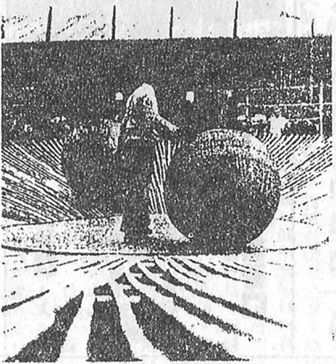
鬥球場開幕時褚民表演情形
Chu Minyi inaugurating the event in the arena:

推球姿勢
A posture of pushing a ball:

繼演太極銅球。太極棍,或推或就。上下疾徐。各盡其妙。
He then performed with the Taiji brass ball and the Taiji stick, pushing and then receiving, up and down, quickly and slowly, displaying all of the ingenuities of the exercises.
太極球架之構造
Structure of the apparatus for the “Taiji ball”:

太極球之表演
Performing with the Taiji ball:

以外尚有竹製小球一。比尋常足球大約五倍。放在地上。可運動足部。在桌上可運動身手。本報第一第二第三圖。
There was also a smaller bamboo ball, about five times the size of an ordinary soccer ball. When put on the ground, it is moved around with the foot. When put on a table, it is moved around by the body or hands. See photos 1-3:


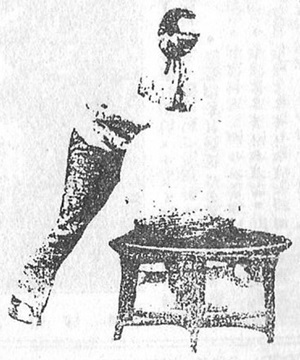
卽為表演竹球之姿勢。褚氏均一一表演。據謂尚須攜往赴比。於萬國博覽會在中國教育館陳列。供外人之參考云。繼由吳鑑泉,徐致一。劉得勝,佟忠義,劉百川,金壽峯,表演拳術助興。吳鑑泉先生之女公子英華女士表演太極劍。尤為出色。是日各報記者持鏡攝影。頗形忙祿。本會亦派郭錫祺君到場攝影。各圖卽為當時所攝
Chu demonstrated the exercises for the bamboo balls one by one. He says he intends to take his inventions with him to Belgium for the Chinese education exhibit at the International Exposition [at Liège, May-Nov, 1930] so that foreigners can take a look at them.
Then performances continued from Wu Jianquan, Xu Zhiyi, Liu Desheng, Tong Zhongyi, Liu Baichuan, Jin Xiufeng, further livening things with boxing arts demonstrations. Wu Jianquan’s daughter Yinghua did a performance of Taiji Sword that was especially outstanding. On that day, every newspaper reporter busily took photographs. The photos of the event included here were taken by our own Guo Xiqi.
–
Here are a few photos from issues 1-3 of 國術統一月刊 Martial Arts United Monthly Magazine, 1934:
全國運動會開幕時褚民誼先生表演太極推手球
Chu Minyi demonstrating the Taiji pushing hands ball during the opening of the National Games:

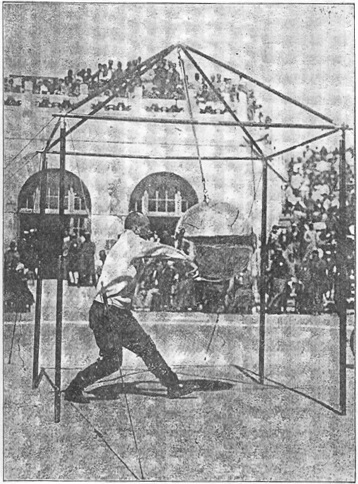
第十八屆華北運動大會國術總裁判褚民誼先生在國術臺表演太極推手球
At the 18th Northern China Exercise Conference, chief referee over martial arts Chu Minyi demonstrating the Taiji pushing hands ball on a martial arts platform:

褚民誼先生放風箏之提倡
Chu Minyi promoting kite flying:

–
Here is an announcement published in 山西國術體育旬刊 Shanxi Martial Arts & Physical Education Weekly, Vol 1, Issue 34, Aug 10, 1935:
褚民誼又發明太極車
CHU MINYI HAS ALSO INVENTED A “TAIJI WHEEL”
[uncredited, thus presumably written by the periodical’s chief editor,
馬耐冬 Ma Naidong]
替中國小妞執鞭,提倡放風箏的行政院祕書長褚鬍先生,他眞是個好動不好靜的人物。他不但歡喜運動,歡喜旅行,歡喜唱戲,還歡喜打拳,據他自己說:『於各種拳術之中,最擅長的是太極拳。』他前幾年早就發明了一種『太極球』,是用藤做故了挺大的球,他用太極拳的手法來推動,直到現今,還是天天在練習着,最近他又發明了一種『太極車』,原來是把銅鑄造了許多輸盤,也像皮球一般的用太極拳手法去推動着,他認為這是一種國術上的新收穫。
他因為提倡和宣傳國術起見,同明星影片公司商定,拍了一本關於他表演太極拳的新聞片,他在拍完之後,很得意地說,這新聞片一定要把他運到外國去放映,藉以宣傳中國的國術。
To keep young Chinese girls from getting left out, Secretary-General of the Administrative Branch Chu Minyi has now also been promoting kite-flying. He certainly has a restless personality. He not only delights in exercise, but also travel, traditional opera, and boxing arts. He has said: “Among the various boxing arts, the most excellent is Taiji Boxing.”
Several years ago he invented a kind of “Taiji ball”, a huge ball made of rattan, which he pushes around using Taiji techniques, and he still practices with it every day. Recently he has also invented a kind of “Taiji wheel”, which is actually turned by means of a brass handle, and resembles the leather ball commonly used for doing Taiji Boxing pushing techniques. He believes this will be another fresh gain for Chinese martial arts. [Unfortunately there is no photo included of the “wheel”, nor any clear description for exactly what this thing is, though it sounds like it might simply be a device that mimics the action of a grinding millstone, as with a basic pushing hands circle. Fortunately the real value of this article lies with the following paragraph.]
Because his purpose is to encourage and propagate martial arts, he talked with the Venus Film Company about shooting a newsreel of him demonstrating Taiji Boxing. After completing the filming, he very proudly said that he will definitely be taking this newsreel with him when he travels abroad and have it shown everywhere in order to publicize Chinese martial arts.
–
The film footage mentioned above:
Its title card says:
中國教育電影協會出品
Chinese Educational Film Society Presents:
褚民誼博士表演中國體育
MASTER CHU MINYI DEMONSTRATING CHINESE PHYSICAL EDUCATION
明星影片公司代製
Produced by the Venus Film Company
The narrator says:
[0:26-1:42]
中國國民政府行政院秘書長褚民誼博士,他對於體育,是很努力的提倡和研究,並且創造許多新的健身方法。所以他現在啊,已經五十三歲了,還具有壯年的體魄。現在褚博士表演一段極簡單的太極拳,我們要知道太極拳的動作是要慢慢的、柔軟的、均勻的、與續不斷的。以動滿,就全身都動,而動臂走環形,使呼吸與血脈,念同天空的行雲和江河的流水一樣的自然流暢。練習的時候,要兩腿須微彎曲,好像騎馬的姿勢,以便於作腹呼吸,使重心下沉,身體穩定。不像取通力運動專練力,也不像靜靜的默坐之專練氣,這於是是一種式身體強健的最好的運動。
Secretary-General of the Administrative Branch of the Chinese National Government, Master Chu Minyi, has put great effort into the promoting and researching of physical education, and has also created many new fitness methods. That is why he now, though already at the age of fifty-three, still has the physique of a young man.* Master Chu will now give a very basic run-through of the Taiji Boxing set.
We should understand that the movements of Taiji Boxing are supposed to be slow, soft, even, and continuous. When the movement is complete in this way, the whole body is moving and the arms are moving in arcs, causing the respiration and circulation to be as natural and smooth as clouds moving in the sky and water flowing in the rivers. When practicing, the legs have to stay slightly bent, as though in a posture of riding a horse, facilitating abdominal breathing, causing the weight to sink and the body to become stable.
It is not like forceful exercises that only emphasize strength, nor like quiet sitting meditations that only emphasize breath. This kind of activity is the best exercise for building up the health of the body.
[*This mention of his age, in conjunction with his known birth year of 1884, seems to have caused many people to assume the film is from 1937, a perfectly natural conclusion. But we must not forget the extra year the Chinese traditionally add for the “year” spent in the womb, meaning fifty-three would really mean fifty-two, pulling the date of the film back to 1936. However, Chu was born on Jan 17, eleven days before the Chinese New Year began for that year. Another peculiar Chinese tradition is that the New Year marks the ticking of the age-metronome rather than one’s actual birthday, and so everyone is considered a year older at the time of the New Year, and this therefore adds yet another year to Chu’s age. Imagining a new-born infant being considered already a two-year-old may cause us some minor seizures, but the fact that the fifty-three therefore turns out to actually mean fifty-one brings the date of the film into satisfactory alignment with the date of the article above – 1935.]
[4:55-6:00]
太極拳練習的方法有兩種:一種是一個人單獨練的,一種是兩個人互相練的,剛才所表演的,是一個人單獨練習的方式。至於兩個人互相練習,是要兩人程度平衡才可合作,常常有找不著對手的困難,禇博士為求解決這個困難,有費了很長時間的研究,創造兩樣科學化的器械了起來,這兩樣器械,就是一根棍和一個球。諸位看,為什麼這根棍在褚博士的身上,能夠這樣子動作滾來滾去?因為這根自管的棍子,是用八根可以自由伸縮的橡皮帶繫住它,所以能夠隨人力的方向而轉移,表演是以為用力從上下、左右、前後,發生種種動作。這根棍都能隨你的意思,運轉自由,和對人練習的時候是一樣的。
There are two types of Taiji Boxing practice methods: one is for one person to practice solo, another is for two people to practice together. What is being demonstrated right now is a solo practice method. As for two-person practice, it requires two people of equal level so they can cooperate. Often there is the difficulty of not being able to find a partner. Master Chu spent a very long time considering the solution to this problem, then created two kinds of scientific apparatus. These two kinds of apparatus are simply a stick and a ball.
Ladies and Gentlemen, why is this stick on Master Chu’s body able to tumble all around in this way? Because this free-standing stick is attached to eight strips of rubber which can stretch and contract naturally, and thus can shift according to the direction of the person’s force. The performer therefore applies force upward or downward, to the left or right, forward or back, producing a variety of movements. This stick will move as you please, circling around freely, and so it is the same as when practicing patterns with a partner.
[6:01-6:32]
現在褚博士來表演這個太極球了。這是一個二十五磅重銅球,是拿一根橡皮帶掛之的。練習的人,站在球的前面或是後面,作種種太極拳的姿勢,於是這個銅球也可以就跟這個太極棍一樣,隨著人力的方向,上下、左右、前後,作環形的轉動。
Now Master Chu will demonstrate the Taiji ball. This is a twenty-five pound brass ball hanging from a single rubber strip. The practitioner stands either in front of or behind the ball, making a variety of Taiji Boxing postures. And so this brass ball can be used in the same way as the Taiji stick: it goes along with the direction of the person’s force – up, down, left, right, forward, back – making circular movements.
[7:14-7:29]
這三座模型,兩座是表明人身脊骨的鬆緊狀態。不運動的人,脊骨是堅硬的;常常鍛煉身體的人,脊骨是鬆動的。
Here are three stands as models. Two of them represent people with tightness in their backs. People who do not exercise will have stiff spines. People who frequently exercise will have flexible spines.
[7:43-8:23]
踢毽子,在中國,是一種最普遍的健身運動,無論在什麼地方,都可以練習。踢毽子的時候,兩腿兩腳的動作,雖然比較多一點兒,但是因為腰和頸部的旋轉,也可以使兩隻手隨著浮動,尤其是人的眼睛,隨著毽子上下、左右而活動,借此也可以練習眼力的正確。我們看褚博士踢毽子的姿態,就可以知道踢毽子,的確也是一種極好的全身運動。
Kicking a shuttlecock is a common fitness exercise in China, for it can be practiced anywhere by anyone. When kicking the shuttlecock, although the legs and feet are moving the most, the twisting of the waist and neck may cause the hands to drift along with the movement. The eyes in particular are exercised as they follow the shuttlecock up or down, left or right. In this way, the practice can correct the vision. From observing Master Chu’s bearing during this performance, we can know that kicking a shuttlecock is surely an excellent means of exercising the whole body.
[8:24-8:50]
射箭在中國古代是人必修的技能,因為它能夠活動筋骨,強健肌肉,又能夠鍛煉精神,和養個性。不過要常常練習它,太容易失中。諸位看褚博士,在十米殼之外,使到第七枝箭,才射到正中定鵠的。
Archery was a mandatory ability in ancient China, because it can liven the physique and tone the muscles, as well as train the spirit and cultivate character. However, it has to be practiced frequently, for it is very easy to miss the target. Let’s watch Master Chu as he goes from the outer circles to sending his seventh arrow straight to the bull’s eye!
–
Here is another priceless piece of Chu footage:
Would someone out there please manufacture these toys so we can all play with them?
–
–
–
